

Barangay Health Management System Capstone Project Document
Introduction.
In today’s information age, advancement of technology change the way of life. It has made various positive changes in almost every field whether it’s medical, business, education, sports or any field you look into. Particularly in most medical clinic facilities, it has made a big impact that enables modern clinics to serve many patients as possible (Qualman, 2018).
As the years passed, the number of patients has grown and various medical cases arise that the manual method of managing patients’ records and prescriptions were moved into computer-based systems.
Barangay Villamonte Health Center is using a manual system in terms of implementing medical services. To improve their services to the community, Barangay Health Management System is proposed to be implemented in the said barangay. It is designed for keeping and monitoring residents medical information in Barangay Villamonte. By this, paper works and manual record keeping will be minimize. Therefore, allowing the nurse and staffs to feel at ease in keeping track of patients and increasing the number of them served.
Background of the Study
Today, different means of record-keeping are used in health care settings. Some workplaces use hand-written records, others have moved to computer-based systems and many use a combination of both.
Barangay Villamonte Health Center is using a manual system in terms of implementing medical services, health programs, health monitoring and profiling. Their medical services and health programs include immunization, medical care, family planning and consultation. While health monitoring includes early childhood care and development and profiling of family profile. All these transactions are recorded manually. To improve the consistency of the consultation process of the said health center, Barangay Health Management System is proposed to be implemented in the said barangay.
The implementation of the Barangay Health Management System provides a quicker and more systematic way to record the medical information of the patients. It also provides reliable and secured personal medical records.
Every consultations or any transactions of the patients will be recorded or stored into a database including the monitoring and updating of the patient health records, how many patient accommodated daily, sickness or complaints report and the medicines released. It will simply increase the performance of medical personnel through its automated information system.
Statement of the Objective
Specifically, the study aims to:
- Design and develop a health management system for Barangay Villamonte that can:
- Allow only authorized user to access and record the medical records of the patients, they can also edit details if needed;
- Ability to easy navigate and manipulate the gathered medical records from the patients in the said barangay;
- Ability to monitor common sickness;
- Electronically record the inventory of medicines;
- View the schedule of their medical services;
- Generate comparative reports of illness in a month or a year to be submitted to the City Health Office (CHO).
- Evaluate the acceptability of the system using the adopted survey instrument based on ISO/IEC 9126 in terms of Effectiveness, Efficiency, Quality , Timeliness and Productivity.
Conceptual Framework
The conceptual framework shows and indicates the flow of the system and helps the users and all the readers understand how it will be processed. This study intends to improve the existing manual way of Barangay Villamonte Health Center. The Barangay Health Management System is an automated information system that is designed for keeping, and evaluating the residents’ heath records.

Figure 1 : Conceptual Framework of BHMS
Scope and Delimitation of the Study
In general, the focus of this study is directed towards the design and development of an automated health management system. This study is largely dependent on the information the barangay health secretary record and keep. This includes all the essential health records of all the residents of Barangay Villamonte.
The system is intended to the persons who have direct involvement in the processing of health programs and other medical services of Barangay Villamonte. The study dealt largely on the recording the Patient Profile Information of the Villamontehanon. The study involves the patients’ personal information such as their name, gender, birthdate, age, birthplace, status and occupation. While contact information includes their contact number, address (purok), guardian and many more. The medical history includes their weight, height, bloodtype, temperature, blood pressure, sickness and medicines received.
Every consultations or any transactions of the patients will be recorded or stored into a database including the updating of the patient health records, how many patient accommodated daily, sickness or complaints report and the medicines released.
Delimitation
In this proposed system, records and files are computerized and stored for accessibility and portability. However, the proponents limit the feature of the secure log-in system to the nurse and staff only. Web-access of the patients is not included.
Other services that the barangay is giving to its residents that requires information such in barangay health center is not part of the study. The proposed system can generate reports to the CHO.
Significance of the Study
The proposed Barangay Health Management System of Barangay Villamonte Heath Center, it will be beneficial for the following:
Barangay Health Worker. The staffs can benefit a lot from this study as they are integral part of the whole clinic management.
Clinic. The proposed system will automate every clinic tasks and can help maximize time spent with patients thereby providing better service to the community.
Nurse. The proposed system will make it easier for the head nurse to manage the clinic and it would be convenient when it comes to retrieving patient health records.
Patients. It will provide better service for the patients and their community.
Researchers. The researchers have developed their writing, analysis and skills in making a good thesis that can help in improving our community as a whole.
Future Researcher. This will benefit other researchers who wish to have similar studies. The results will serve as their background information in conducting their own research.
Definition of Terms
The definition of terms are based on concepts taken from the dictionary or web.
CHO. Conceptually , the term CHO is an acronym for City Health Office. It was created by virtue of Article 8 Title 5 Book 2 of the Local Government Code. Its mandate is to formulate and implement policies, plans, programs and projects to promote the health of the people in the city and to execute and enforce all laws, ordinances and regulations pertaining to public health.
Operationally,
Data. Conceptually, the term data is an information output by sensing device or organ that includes both useful and irrelevant or redundant information and must be processed to be meaningful. (Merriam-webster.com, 2017)
Operationally, it is a collected information that is processed and stored in a computer.
Database. Conceptually, the term database is a large collection of data organized especially for rapid search and retrieval as by a computer. (Merriam-webster.com, 2017)
Operationally, the proponents use the database to collect data and help make the Barangay Health Management System.
Inventory. Conceptually, the term inventory means to make a complete list of. (Merriam-webster.com, 2017)
Operationally, the term inventory means making a list of medicines available in the health center as well as other stocks.
Management. Conceptually, the term management is the process of dealing with or controlling things or people. (Merriam-webster.com, 2017)
Operationally, management is the process of controlling the inflow of day-to-day operations in the clinic, the programs as well as the schedules to be made.
Profiling. Conceptually, the term profiling is the act or process of extrapolating information about a person based on known traits or tendencies. (Merriam-webster.com, 2017)
Operationally, profiling is the process of filing medical informations about a resident in barangay Villamonte based on his/her medical history.
Recording. Conceptually, the term recording means setting down in writing or some other permanent form for later reference. (Merriam-webster.com, 2017)
Operationally, recording is having a chronological written account of a patient’s examination and treatment that includes the patient’s medical history and complaints, the physician’s physical findings, the results of diagnostic tests and procedures, and medications and therapeutic procedures.
Scheduling. Conceptually, the term scheduling means the arrangement or plan (an event) to take place at a particular time. (merriam-webster.com, 2017)
Operationally, the term scheduling is used to mean the time or schedule of consultation. It also determines when an activity should start or end depending on the duration.
Transaction. Conceptually, the term transaction is an exchange or interaction between people (Merriam-webster.com, 2017).
Operationally, transaction is the interaction between health staffs and patients. How many patient accommodated daily, sickness or complaints report and the medicines released.
Villamontehanon. Operationally, the term Villamontehanon refers to people living in Barangay Villamonte.
Review Of Related Literature
This chapter discusses the existing study into the context of proceeding related research. This research study cited articles and systems related to the research topic.
Local Studies
Barangay Management Information System for Cities and Municipalities in the Philippines
The Barangay Management Information System for Cities and Municipalities in the Philippines is a program which contains features that records and manages information and at the same time can send documents from barangay hall to the city hall. Barangay Management Information System for San Carlos City is an online and offline system to keep, process, retrieve and update Barangay and City Hall information through a secure network interface. It is designed to handle a wide-range of information relating to barangay profile, constituents profile, barangay clearances, barangay disputes/cases, barangay activities, and barangay legislation and City Hall’s required reports from the barangay. It covers all the functions, activities and transactions of the barangay which aims to provide complete and accurate information for the barangay and city hall management and stakeholders. The study was the solution to the problems stated and to enhance the quality of service a barangay office offers to its clients (Soriano et. al, 2018).
Computer-based information operates through the use of software that can offer information services for an institution or organization. It is powerful and convenient builder for simultaneous growth in society and industries. An information service provides a way to electronically access, retrieve, and transmit that information.
Furthermore, this serves as an awakening factor for all government offices, from highest to lowest levels, to be in line with the government’s view of globalization and competitiveness in today’s information age. (Henczel, n.d.)
Barangay Health Center Information System
The implementation of the Barangay Health Center Information System simply improves the consistency of the consultation process of the Barangay Dian-ay Health Center. It is very useful to both the Barangay Health Center and to the patients. To monitor all the Patients health records is very necessary. Through this system it provides satisfaction & better service to the beneficiary/community it is serving.
It will increase the performance of medical personnel through its system generated consultation. To help the health center of Barangay Dian-ay continually do their mission, vision, and goals through providing their services fully hearted to the Patient/Community of the Barangay Dian-ay for the medication/treatments. (Allura, n.d.)
Foreign Related Studies
Integrated System Health Management
A sensor system and its optimal deployment, selection and information fusion are the basic research areas of ISHM. Schmalzel proposed a smart sensor-based health management system architecture. Nickson developed a networked intelligent wireless sensor for engine health management. Bonissone proposed a framework for computational intelligence in ISHM, which defines the time horizons for ISHM decision-making across products and the type and structure of domain knowledge. NASA has conducted a number of institutions on aircraft engine health management to develop data-mining methods for aircraft engine health management and enhanced self-tuning airborne real-time models to enable adaptive hybrid data and information fusion applications.
An important part of integrated system health management (ISHM) is performance assessment, which is conducted at all important space exploration system stages; development, stereotypes, production, and equipment. Spacecraft system design has a long development cycle, generally goes through several phases such as the identification of technical indicators, conceptual design, detailed design, prototype construction, validation tests and flight tests and encompasses considerations such as costs and risk assessments. Therefore, accurate and reliable performance assessment drives design adjustments and predicts maintenance requirements and early fault diagnostics and prognostics. As launch success rate assessments are considered the most important space exploration system performance evaluations, using lunar exploration as an example, this chapter proposes enhanced launch success ratio assessment models to illustrate ISHM performance evaluations. (Figueroa et. al, 2006).
Related Systems
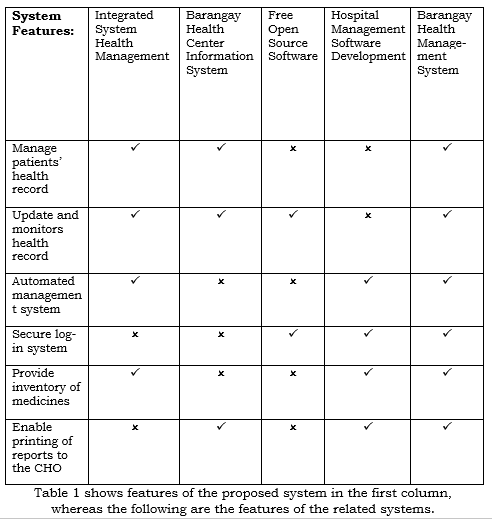
The system presented were obtained from both foreign and local system study that were made basis for the developed of health management system. It describes some features that are available on the system but some are not available with the local and foreign study.
According to the journal entitled, Reducing the frequency of errors in medicine using information technology ; appropriate use of information technology in health care resulting in process simplification could result in substantial improvement in patient safety. The growing demand for the quality healthcare should carry out planning, monitoring and controlling the delivery system. This characteristics are the main features of the Barangay Health Management System.
Thus, the related system shares similar nature to the study but the proponents observed the lack of features which are important such as management of patients’ health records; automated management system; secure log-in system; inventory of medicines; generate the monthly reports to the CHO. Hence, the proposed system includes all the needed features specifically tailored for Barangay Villamonte Health Center.
Methodology
This chapter discusses the research strategy and procedures on how the system flows and its phases.
Software Development Life Cycle
Tatva (2013) states that Rapid Application Development (RAD) is an effective methodology to provide much quicker development and higher-quality results than those achieved with the other software development methodologies. It is designed in such a way that, it easily takes the maximum advantages of the software development. The main objective of this methodology is to accelerate the entire software development process. The goal is easily achievable because it allows active user participation in the development process. The Rapid Application Development Model is broken down into different phase. Basic phases of Rapid Application Development are as follows: Requirement Planning, Prototyping (user design and construction), Testing and Cutover.
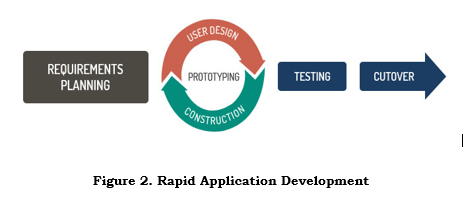
Rapid Application Development
Requirements Planning
During this initial stage, after we selected our team members. The Researchers assigned tasks and assignments to each other. After the researchers did their brainstorming about the title of the system, they did the interviews and surveys to the Barangay Health Worker (BHW) of Villamonte. Here, they also sought for some related studies of the system.
Prototyping
In this phase, the researchers selected Rapid Application Model as the best methodology that would fit best for the system and the team. Also, in this phase, modeling was created to give a better view for the researchers for the overall scope of the system and its processes. After,
the prototype was created to give the programmer the design of the system. Then, the coding started.
Proponents have conducted a testing survey where 30 respondents from the Health Center and their staffs evaluated the system using the User Acceptance Survey. To see whether it functions and operates just how they want it.
Results the final tasks in the SDLC implementation phase, where the system was concluded to function well. In this phase, the system was again presented and trainings were made for the staffs of the company. It will all be up to the City Health Officer if she would want to use the system for their health center.
Operational Feasibility
Bootstrap is an open source toolkit for developing with HTML, CsS and Js. Quickly prototype your ideas or build your entire app with Sass variables and mixins, responsive grade system, extensive prebuilt components, and powerful plugins built onXx x Jquery. (Wama Software, n.d)
PHP is a server-side scripting language desined for web development but also used as a general-porpose programming language. Originally created by Rusmus Lerdrof in 1994, the PHP reference implementation is now produced by the PHP group (Wikipedia, n.d.)
Technical Feasibilit y
Hardware requirements specification.
The Barangay Health Management System has the appropriate hardware that is suitable in following maximum and recommended hardware services helpful to the development of the system study.
Table 2.0 Hardware Specification
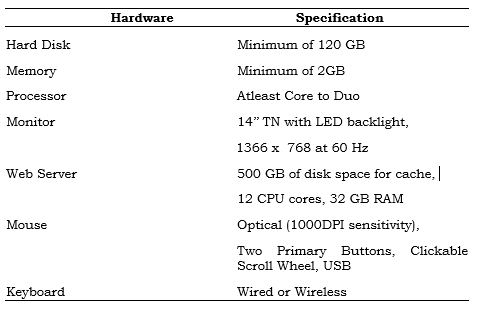
Hardware Specification
Software Requirements Specifications
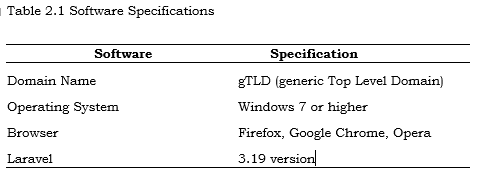
Software Specification
System Architecture
Figure 3.0 illustrate how the system will flow. The patients go to the health center in a scheduled time based on the center’s scheduling. The BHW then ask the patient about his/her personal information as well as their medical history. All these facts are encoded by a BHW. After they have assisted their patients, they will go see the doctor.
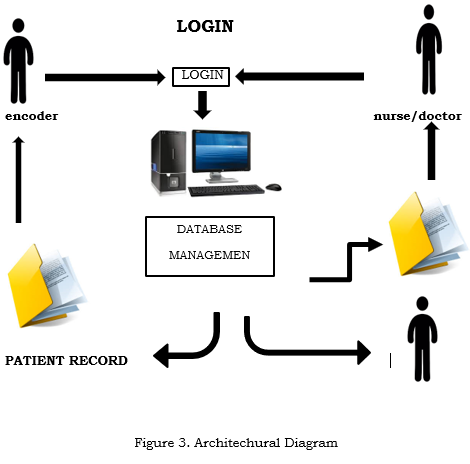
Architectural Diagram
Feasibility Schedule
The feasibility schedule contains the record of the amount of time the proponents spent on the system.
Gantt Chart
The following tables show the Gantt chart of the tasks that have been done by the proponents with the time allotted for the establishment of the entire system.
Table 3. Requirement Planning

Requirement Planning

Cost Benefit Analysis
Cost Benefit Analysis or the CBA is a process wherein business decisions are analyzed. The benefits of a business-related action are summed and the costs associated with taking that action are subtracted to determine whether the company can benefit from the system.
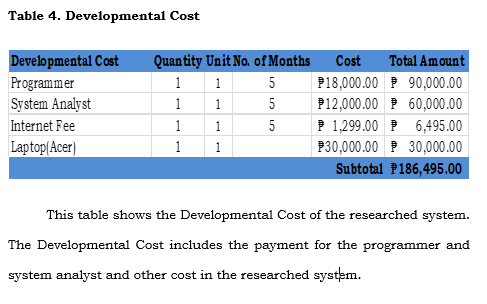
Developmental Cost
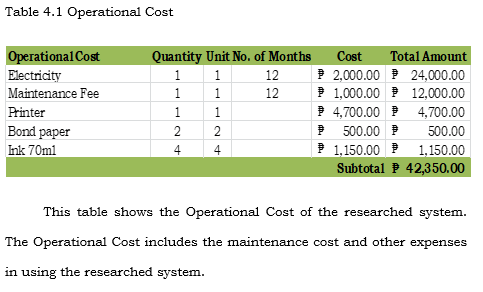
Operational Cost

Benefit of the System
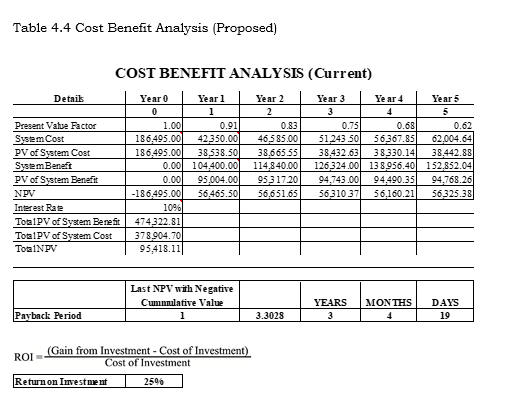
Table 4.4, shows a chart of the Cost and Benefits Analysis. The Return of Investment comes out of 25%. The Payback Period was computed by taking the sum of the Present Value of System Benefit (Php 95,004.00) subtracting it to the Present Value of System Cost (Php186,495.00) to get its Net Present Value and get the sum of Net Present Value (Php 56,465.50) subtracting it to the negative value of System Cost (Php -474,332.81), and dividing the difference Net Present Value (Php 56,465.50). Resulting to 1.64 which is round to 2, making it a 2-year payback period. Payback period Initial Investment/Cash Inflow. The ROI was computed by taking the sum of the Total Present Vahie of System Benefits (Php 474,332.81), subtracting it to the Total Present Value of System Cost (Php 497,185.08), and dividing the difference Total Present Value of System Cost (Php 378,904.70). The quotient is is equivalent to 25% of ROI or Return of Investment. The formula that the proponents used can be seen on Table 4.4.
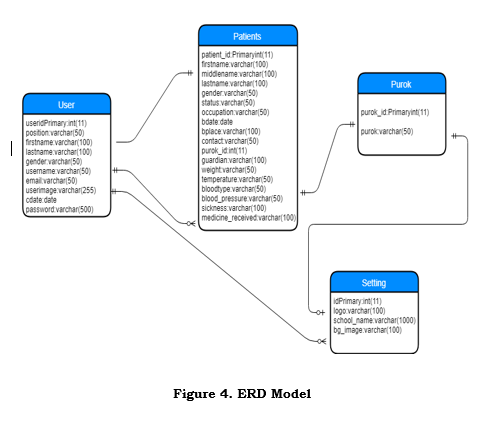
Data Flow Diagram
The flow of the system begins when the user process daily check up. After the all data will be converted into information and stored inside data base, and then data inside the database can be accessed by the admin.
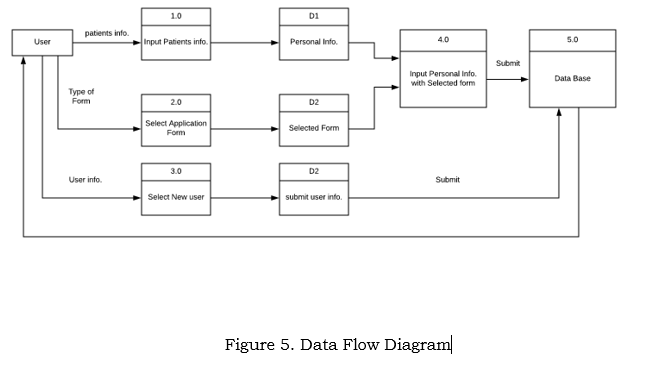
Data Dictionary
Table 5. Patient
Table 5 shows the patient’s information composes of Id, Fname, Mname,, Lnam, Gender, Status, Occupation, Bdate, Bplace, ContactPurok_id, Guardia, WeightTemperature, Blood Type, Blood pressure, Sickness, Medicine received
Table 5.1 Purok
Table 5.1 shows the details of purok.
Table 5.2 Setting
Table 5.2 shows the details of setting.
Table 5.3 User
Table 5.3 shows the table of user pomposes of User_id, Position, Fname, Lname, Gender, Username, Email, Userimage, Cdate, password.
Presentation, Analysis, and Presentation of Data
This chapter exhibits the results of the User’s Survey conducted for the system to the Barangay Health Worker and Villamontehanon.
Presentation
The proponents demonstrate the system’s functionality to the randomly selected respondents. The proponents observed the respondents on how they response to the system. The respondents were evaluated using the User Acceptance Survey in order for the them to distinguish the level of acceptability of the proposed system.
Data Analysis
To interpret the results of the survey, the researchers utilized a statistical tool to provide meaningful data for the survey conducted. According to Bettany-Saltikov & Whittaker (2014), it is important to select a statistical test which can answer the researcher’s objectives of the study and the field of research.
This section presents the analysis of the data collected and gathered from the respondents: Barangay Health Workers, Villamontehanon, Barangay Kagawad and Barangay Staffs.
Characteristics of the Respondents
Table 6. Frequency of Respondents
Respondents Frequency
City Health Officer 1
Barangay Health Workers 6
Villamontehanon 15
Barangay Kagawad 1
SK Chairman 1
Barangay Staffs 6
Total 30
The population is composed of the City Health Officer, Barangay Health Workers, Villamontehanon, Barangay Kagawad and Barangay Staffs. The proponents got thirty respondents from the administration and Barangay staffs.
Table 6. shows the number of respondents who have answered the User-Acceptability Survey. The researchers got a total number of 30 respondents.
Participants of the Study
The population of the study was determined using purposive sampling with 30 identified participants intended for the system which is comprised of a City Health Officer, Barangay Health Workers, Villamontehanon, Barangay Kagawad and Barangay Staffs. This was supported by Edralin (2002) which states that “selection of key informants is based on predetermined set of criteria”.
Interpretation of Data
Table 6.1 Verbal Interpretation
Mean Score Range Verbal Interpretation
4.21-5.00 Very Satisfied
3.41-4.20 Satisfied
2.61-3.40 Dissatisfied
1.81-2.60 Very Dissatisfied
1.00-1.80 Poor
The evaluation of the system was conducted using the adopted survey instrument based on ISO/IEC 9126 in terms of five (5) categories namely: Effectiveness, Efficiency, Quality, Timeliness and Productivity.
The items of the evaluation instrument were appropriate for field testing situation. The first category was composed of four (4) items, the second category was composed of three (3) items, and the third, fourth and last categories were composed of four (4) items. Table 6.6 shows that the user’s survey result for the system’s quality came back with a total mean of __which interpret that the users were very satisfied with the system’s quality after testing it.
Effectiveness
Table 6.2 Survey Result – Effectiveness
System Quality Performance Total Mean Verbal Interpretation
Effectiveness 4.65 Very Satisfied
Table 6.2 shows that the user’s survey result for the effectiveness of the system came back with a total mean of 4.65 which is interpret as “Very Satisfied” which means that the end-users were satisfied with the system’s effectiveness after testing it.
The respondents stated that the proposed system (BHMS) meet the desired result and produces the desired output. They also stated that the system is effective, it means that the level of functionality of the developed Information System is high.
Table 6.3 Survey Result – Efficiency
Effeciency 4.67 Very Satisfied
Table 6.3 shows that the users survey result for the system’s efficiency came back with a total mean of 4.67 which interpret that the users were very satisfied with the efficiency of the system after testing it.
The respondents stated that the system (BHMS), has the ability to avoid wasting materials, energy, efforts, and time in generating and recording statistical reports. In a more general sense, the system (BHMS) has the ability to do things well, successfully and can be easily performed.
Table 6.4 Survey Result – Quality
Quality 4.65 Very Satisfied
Table 6.4 shows that the user’s survey result for the system’s quality came back with a total mean of 4.65 which interpret that the users were very satisfied with the system’s quality after testing it.
The respondents stated that the system (BHMS), meet the standards of the users in terms of its degree of excellence.
Table 6.5 Survey Result – Timeliness
Timeliness 4.67 Very Satisfied
Table 6.5 shows that the user’s survey result for the system’s quality came back with a total mean of 4.67 which interpret that the users were very satisfied with the system’s quality after testing it.
The respondents stated that the system (BHMS), has the quality in generating and recording statistical reports in favorable or useful time. Furthermore, Nelson, Todd and Wixom (2005) added that the accuracy of the information and being up-to-date most of the time is vital for a system.
Productivity
Table 6.6 Survey Result – Productivity
System Quality Performance Total Mean Verbal Interpretation
Productivity 4.76 Very Satisfied
Table 6.6 shows that the user’s survey result for the system’s quality came back with a total mean of 4.76 which interpret that the users were very satisfied with the system’s quality after testing it.
The respondents stated that the system (BHMS) has the ability to produce a desired result. It also implies that the users are able to find the system as simple to use which led them to have better efficiency and speed in accomplishing their tasks as compared to their previous process without the system.
Table 6.7 Survey Result – Over All
Over All 4.68 Very Satisfied
Referring now to the overall impression of the users toward the Barangay Health Management System as shown in table 6.7, it obtained a “Very Satisfied” level of satisfaction with a mean of 4.68.
This implies that the system is functional and addresses the objectives of this study with high approval towards its users. It is also evident that the users were satisfied with the system, simply means that their existing system of record-keeping had difficulties and was successfully addressed by BHMS. Furthermore, this would also mean that the system made the users felt comfortable by utilizing the system due to its simplicity but at the same time making them more productive.
Summary Of Findings, Conclusion And Recommendation
This chapter presents the summary of the findings, and the conclusions and the recommendations for the system study.
Summary of Findings
The result of the evaluation of the system arrived at the following findings:
- The Overall Satisfaction (overall) of the Barangay Health Management System which was taken from the average responses of the different categories from the survey instrument was “4.68” interpreted as “Very Satisfied”.
- The system Effectiveness which was taken from the average responses of first category from the survey instrument was “4.65” interpreted as “Very Satisfied”.
- The system Efficiency which was taken from the average responses of first category from the survey instrument was “4.67” interpreted as “Very Satisfied”.
- The system Quality which was taken from the average responses of first category from the survey instrument was “4.65” interpreted as “Very Satisfied”.
- The system Timeliness which was taken from the average responses of first category from the survey instrument was “4.67” interpreted as “Very Satisfied”.
- The system Productivity which was taken from the average responses of first category from the survey instrument was “4.76” interpreted as “Very Satisfied”.
The system got an overall result of “4.68” which indicates that the users “Very Satisfied” with the usefulness of the Barangay Health Management System. This means that the system meets the objectives of the study. It also indicates that the system is able to provide the barangay health center a system that performed accordingly to its functions and purpose. In other words it has addressed the necessary automation requirement of the center after the thorough system study.
Recommendations
Based on the findings and conclusions of the study, the following recommendations were given:
- The system would be best implemented in the health centers of every barangay in Bacolod City.
- Add more features such as communication of the Barangay Health Workers (BHW)and patients.
- Add more features where in patients can be updated during their scheduled consultation and others.
- The system must have maintenance for every six (6) months to maintain and update its functions and also for security of its databases.
- Further research is encouraged to extend the applicability of the system to other areas.
Pescadero, Joel A.
Saltore, Jhon Michael
Toledo, Lino S.
Share This Post!
- Capstone Project
Recent Posts
Boarding house management system: simplify your life as a landlord, revolutionizing the hospitality industry: top 50 it projects for hotel and tourism, inn management and reservation system capstone project document.
- Student Academic Discipline System Capstone Project Document
- Events Tabulation System Capstone Project Document
- November 2022
- February 2022
- September 2020
- August 2020
Share This Event!
About the author: capstoneguide.
Related Posts

Leave A Comment Cancel reply
You must be logged in to post a comment.
The State of the Barangay Health Centers of Tanauan City, Batangas: An In-Depth Study
- DSpace Home
- Department of Social Sciences
- BA Development Studies
Show simple item record
Files in this item
This item appears in the following collection(s).
- BA Development Studies Bachelor thesis of BA Development Studies
Search DSpace
All of dspace.
- Communities & Collections
- By Issue Date
This Collection
Volume 20 Supplement 1
Marketing communications in health and medicine: perspectives from Willis-Knighton Health System
- Research article
- Open access
- Published: 11 September 2020
Connecting communities to primary care: a qualitative study on the roles, motivations and lived experiences of community health workers in the Philippines
- Eunice Mallari 1 ,
- Gideon Lasco 2 ,
- Don Jervis Sayman 1 ,
- Arianna Maever L. Amit 1 ,
- Dina Balabanova 3 ,
- Martin McKee 3 ,
- Jhaki Mendoza 1 ,
- Lia Palileo-Villanueva 1 ,
- Alicia Renedo 3 ,
- Maureen Seguin 3 &
- Benjamin Palafox ORCID: orcid.org/0000-0003-3775-4415 3
BMC Health Services Research volume 20 , Article number: 860 ( 2020 ) Cite this article
85k Accesses
23 Citations
6 Altmetric
Metrics details
Community health workers (CHWs) are an important cadre of the primary health care (PHC) workforce in many low- and middle-income countries (LMICs). The Philippines was an early adopter of the CHW model for the delivery of PHC, launching the Barangay (village) Health Worker (BHW) programme in the early 1980s, yet little is known about the factors that motivate and sustain BHWs’ largely voluntary involvement. This study aims to address this gap by examining the lived experiences and roles of BHWs in urban and rural sites in the Philippines.
This cross-sectional qualitative study draws on 23 semi-structured interviews held with BHWs from barangays in Valenzuela City (urban) and Quezon province (rural). A mixed inductive/ deductive approach was taken to generate themes, which were interpreted according to a theoretical framework of community mobilisation to understand how characteristics of the social context in which the BHW programme operates act as facilitators or barriers for community members to volunteer as BHWs.
Interviewees identified a range of motivating factors to seek and sustain their BHW roles, including a variety of financial and non-financial incentives, gaining technical knowledge and skill, improving the health and wellbeing of community members, and increasing one’s social position. Furthermore, ensuring BHWs have adequate support and resources (e.g. allowances, medicine stocks) to execute their duties, and can contribute to decisions on their role in delivering community health services could increase both community participation and the overall impact of the BHW programme.

Conclusions
These findings underscore the importance of the symbolic, material and relational factors that influence community members to participate in CHW programmes. The lessons drawn could help to improve the impact and sustainability of similar programmes in other parts of the Philippines and that are currently being developed or strengthened in other LMICs.
Peer Review reports
Community health workers (CHWs) are an important cadre on the frontline of health systems in many low- and middle-income countries (LMICs). The 1979 Alma Ata Declaration on Primary Health Care (PHC), with its call for both more health workers and greater community participation [ 1 ], paved the way for CHWs to assume a greater range of functions, from health promotion to case management, with growing evidence of their increasing role which they have been shown to execute effectively and with good value for money [ 2 ].
In many parts of the world, CHWs are seen as a means to deliver culturally appropriate health services to the community, serving as liaisons between community members and health care providers [ 3 ]. To achieve this, health systems and programmes typically enlist lay individuals with in-depth understanding of the culture and language of the communities from which they are drawn, with the expectation that they will require only minimal education and in-service training, although this will depend on their scope of work [ 4 ]. In 1981, the Philippines was one of the first countries to implement at scale the Alma Alta recommendation of PHC based on community participation (Fig. 1 ) [ 5 ].

Timeline on the development of the Barangay Health Worker role in the Philippines (1978–2020). This figure illustrates the key events related to the introduction and developing role of Barangay Health Workers in the Philippines, since their introduction in the late 1970s to the present day. BHW Barangay Health Worker; CHW community health worker; LGU local government unit; NCD non-communicable disease; NGO non-governmental organisation; PHC primary health care
Operating at the level of barangays or villages, the smallest unit of governance in the Philippines, volunteer Barangay Health Workers (BHWs) have evolved to become an essential component of the nation’s healthcare workforce [ 6 , 7 , 8 ] and have been key to the success of PHC in the country [ 5 , 8 ]. In recognition of their contribution, the Philippine Congress passed the BHWs’ Benefits and Incentives Act (Republic Act 7883) in 1995 (Fig. 1 ), which is the most recent major reform to the BHW role. The law aimed to empower BHWs to self-organise, to strengthen and systematise their services to communities, and to create a forum for sharing experiences and recommending policies and guidelines [ 9 ]. The law also required local governments to offer benefits and allowances to BHWs, as well as scholarships for their children. The only constraint imposed by the law was that the number of BHWs could not exceed 1% of the community’s population. In practice, however, the number of BHWs, along with the scope of their responsibilities and the size of their allowances, are determined by the budget of the decentralised local government health board covering the barangay to which BHWs are assigned.
BHWs have now existed in the Philippines for almost four decades and have often been commended in evaluations of local health systems and community participation [ 6 , 10 , 11 ]. Yet, we lack a good understanding of what motivates and sustains their involvement on a largely voluntary basis. This understanding is crucial as the programme’s continued success and sustainability relies on its ability to motivate and mobilise community members to act as peer health advocates – and the difficulty of realising such community mobilisation has been noted [ 12 ]. The longevity of the Philippine BHW programme, especially when compared with more recent CHW models elsewhere, provides an excellent case study to explore these topics in depth.
This study aims to address this gap by documenting the experiences and roles of BHWs in selected urban and rural sites in the Philippines. We follow Campbell and Cornish’s approach that draws attention to relational and material aspects of the social context of participation, enhancing understanding of facilitators to community mobilisation to improve health [ 12 ]. This helps identify contextual dimensions often neglected in the literature that undermine or support community members’ motivation to participate in the BHW programme and sustain their involvement over time [ 12 , 13 ]. As many countries are in the process of implementing new CHW programmes or strengthening existing ones, the findings from this study could inform ‘task shifting’ programmes and policies that seek to empower and mobilise communities to take more control over their health by means of CHWs [ 14 ], both in the Philippines and in other LMICs.
This study was conducted as part of the Responsive and Equitable Health Systems-Partnership on Non-Communicable Disease (RESPOND) project, which uses longitudinal mixed-methods to better understand health system barriers to care for hypertension as a tracer condition for non-communicable diseases (NCD) in the Philippines [ 15 ]. The study was conducted in purposefully selected urban barangays in the City of Valenzuela and rural barangays in Quezon province, and data for this analysis was collected via semi-structured interviews with BHWs as part of the facilities assessment component of the RESPOND project.
Data collection and management
A senior in-country, bilingual, social scientist researcher led the data collection and supervised two in-country, bilingual, trained research assistants (one male, one female) with relevant experience and backgrounds in communication and public health in administering semi-structured interviews in pairs in Filipino. A total of 23 BHWs were purposefully recruited, 13 from Valenzuela City and 10 from Quezon province, to maximize diversity of experience in terms of length of service, education and age, across the participating barangays. All BHWs in the study sites were women and those agreeing to participate in the study varied in age from 35 to 75 years. All but one were married. Their lengths of service ranged from 1 to 38 years, with 8 possessing 11 or more years of experience. Two participants reported recently returning to their duties following periods undertaking parental and household duties. The educational background of participants ranged from primary school to undergraduate degree. None received formal training as a health professional prior to starting their roles as BHWs.
The interview guide focused on their motivations for becoming a BHW, their day-to-day experiences of developing their role and responsibilities in the community, and their understanding of hypertension (Supplementary File 1). As BHWs in RESPOND project communities were engaged in the sampling of the household survey component, they were approached directly and oriented to the nature of the BHW study. Written informed consent was acquired from those who wished to participate, and interviews with each were arranged and conducted by the two research assistants in Filipino as the mutually shared language. Because all interviewees were women, it was considered important to include a female and male interviewer who could work flexibly to minimise response bias. Interviews were conducted and audio recorded in a secure place selected by participants between September 2018 and October 2019, lasting 30–60 min. After 15 interviews, data saturation was reached and subsequent interviews were conducted to ensure no new data was generated and to maximise sampling diversity.
Following each interview, written notes were reviewed jointly by the research assistants and BHWs to ensure accurate representation and interpretation. The two research assistants transcribed each interview recording verbatim in Filipino, and the fidelity transcriptions was assessed by the senior researcher against the recording. Anonymised transcripts were produced by removing all personal identifiers and attributes, and participants were assigned a pseudonym, which have been applied throughout this report. Research notes and signed consent forms were stored in locked cabinets accessible only to the research team. All digital audio recordings, digitised research notes, and original and anonymised transcript files were stored separately on secure, encrypted and password protected servers or laptops. All non-anonymised research material (e.g. audio recordings, original transcripts, notes) will be destroyed at project end, while consent forms and anonymised transcripts will be kept securely for 7 years thereafter.
Data analysis and rigour
Verbatim transcriptions in Filipino were analysed using NVivo 12 software [ 16 ]. The senior social scientist led the open reading of the Filipino transcripts and several rounds of coding using a thematic approach [ 17 ] with the research assistants. The coding frame emerged, in part, inductively through multiple, iterative readings of the interview transcripts, but was also informed from our a priori interest in motivations and experiences of BHWs, drawing on Campbell and Cornish’s approach to examining how a “health enabling social environment” affects community mobilisation and participation [ 12 ]. After several rounds of coding, analytical memos of emerging and recurring themes were shared with the broader research team, who have expertise in primary health care, health system strengthening in LMICs and the local context, to conduct interpretation and contextualisation via regular discussions in English, ensuring the relevance and transferability of the results both locally and globally. This also included critical assessments of the findings’ plausibility, consistency with other research of findings, and in light of researchers’ own biases, preconceptions, preferences, and dynamic with the respondent (i.e. researchers were health professionals and/or staff of well-known universities) to ensure validity. Key themes, supporting quotations and statements included in memos (and subsequently in the manuscript) were extracted from interview transcripts and translated to English by the bilingual research assistants; and the quality of translations was assessed by bilingual senior researchers by checking and rechecking transcripts against the translated interpretations [ 18 ].
Informed consent and ethical approval
Ethical approval for the research was obtained from the local research ethics board of the University of the Philippines Manila Panel 1. We obtained written informed consent from BHWs prior to the interview, ensuring that their anonymity, privacy and confidentiality would be maintained. BHWs were advised of their right to withdraw their participation at any time, although none of the participating BHWs did so.
In this section, we summarise the lived experiences of community members who volunteer as BHWs in our urban and rural study locations. We also describe the salient themes from these accounts that relate to factors that influenced their initial motivation to volunteer and that determine their continuing involvement.
Becoming a BHW: the role of socio-political positioning and technical knowledge
The social relationships and political positioning of BHWs played an important role in their pathway to participation in the local health system (i.e. recruitment, appointment, and continuing inclusion). Recruitment was largely dependent on having these socio-political connections rather than on having the right skills or technical knowledge to deliver health services. The barangay captain, the leader of the village administration, holds the power to appoint BHWs, and with no formal guidelines to follow, appointments are arbitrary. Some BHWs recalled that they or their peers were appointed by the captain as a result of personal or political relationships, or following a recommendation from other barangay officials, including current BHWs or health staff. Some of the reasons cited for these endorsements included a history of active involvement in barangay activities, such as programmes on feeding, family planning, and fitness. For example, Amy (1 year in service) shared:
I volunteered myself and I said to [the barangay councillor] that if he wins, [allot me a position]. I’ve been applying since before, but I was not given the opportunity. I only volunteer. When he won a seat, I finally got a position at the [health] centre. [The councillor] is my husband’s buddy .
Importantly, however, there need not be any reason for the endorsement other than the prospective BHW’s need for a job, as Ellen (2 years in service) recalled:
My livelihood then was to wash and iron clothes and take to care of children. But when I had a grandchild I could no longer do those tasks, so I asked the barangay treasurer (who happens to be my co-godmother) for any available jobs in the barangay. She told me that they can make me a BHW, so I suddenly became one.
Ellen’s example points to the informality of the application process to become a BHW, something supported by most respondents’ accounts. Cea (11 years in service) recalled that she was interviewed by the local doctor and simply asked (not assessed) about her capacity to work in health centre: “I was interviewed and she asked, ‘Can you do community area activities? Can you do duties in the health centre? Can you do all of this?’” Skills and professional qualification, while useful, are largely secondary to personal connections.
Given that barangay captains are elected every 3 years and their power to appoint (or remove) BHWs, one’s position may not be secure when administrations change. Many BHWs recalled instances when they or their former peers were dismissed because they were not allied politically with the newly elected captain’s party. Luisa (5 years in service) shared that she was dismissed because her religious values did not permit her to vote; while Catherine (6 years in service) recalled that she was dismissed unexpectedly at an earlier point in her career:
We thought that they would not remove anyone, including BHW positions. I was confident. I did not even vote and had no involvement in the political system. After the election on July 1, I went to the barangay office and my name was not included on the list of BHWs.
While a connection to barangay officials appears to be a common route to becoming a BHW, involvement with the wrong politician or non-involvement in politics can also be liability, underscoring the political nature of the position. However, several examples of more merit-based appointments were noted, such as where applicants had previously volunteered for other community activities or programmes (e.g. in the barangay day care centre) or assisted existing BHWs.
Mediating health: bridging and linking community members to services
In general, the activities performed by BHWs involved two roles: serving as frontline health centre staff and acting as community health mobilisers. However, the balance of activities depended on the priorities of the health centre manager to which the BHW was assigned. BHWs were commonly involved in various health centre programmes, including immunisation, maternal care, family planning and hypertension management. Their weekly schedules varied from barangay to barangay, but they typically spent the whole day in health centres 2–3 times a week.
As frontline staff at local health centres, BHWs are often the first point of contact for patients. They welcome patients and perform a range of specific tasks, including admitting and interviewing patients and recording patient information and/or vital signs (e.g. blood pressure), before being seen by a doctor or nurse, if available. BHWs confirmed that their role did not involve diagnosing or prescribing.
As community health mobilisers, BHWs serve as a bridge between the community and their local health centre, promoting health and engagement with existing services, often working house-to-house. They particularly encourage uptake of programmes such as child feeding and NCD prevention and screening at health centres. While they are not allowed to dispense medicines, administer vaccines, or provide direct patient care, they play a supportive role, which includes assisting midwives, blood pressure monitoring, and talking to and motivating patients to adopt appropriate health behaviours. Gina ( 38 years in service) shared:
We encourage them. This is our job: to encourage them that we have a health centre and to seek help if they feel something.
BHWs also assist patients in the community with self-management of their chronic conditions. For instance, they measure the blood pressure of those with hypertension at both the health centre and during house-to-house visits, take the opportunity to remind patients of upcoming follow-up appointments, advise them if medicines are available at the health centre for prescription refills, and educate community members. Ruby (22 years in service) shared:
I remind them that they should not be confident if they don’t feel anything [symptoms]. We don’t know if we have hypertension.
BHWs’ role as community health mobilisers also includes a public health surveillance component, following up on non-adherence and surveying prevailing health conditions in the community. April (8 years in service) described:
If we are not in the health centre, we visit our assigned area. We ask who is pregnant. We ask who is sick. We ask who has tuberculosis. We also do lectures on tuberculosis.
Denden (10 years in service) also described:
We visit them. We knock on their doors and ask why they don’t visit the centre. We remind them to finish the programme. If they give us a chance, we explain the need to continue the programme. It’s like the patient and I are a tandem.
BHWs’ local knowledge and position in the community are useful assets in their role as health mediators, helping them to identify health needs and engage with community members to link them to services . Maria (2 years in service) talked about using her local knowledge and position in the community to achieve this:
We know for example in our community who has tuberculosis. We always research them, so that we encourage them to undergo treatment. During immunisation, we notify parents to bring their child to the health centre.
BHWs also mentioned that they are often approached by patients before they have reached the health centre, which suggests that they enjoy a high level of trust among community members as intermediaries of the health system. Lili (11 years in service) told us about being contacted often by patients asking for medicines and using this opportunity to remind then about the importance of engaging with services to “ consult the doctor before taking medicine. It’s just not about taking medicine.”
Contracting arrangements and compensation
BHWs are considered part-time, volunteer workers and not government employees. Hence, they do not receive a regular salary. However, BHWs from rural areas reported being given honoraria and allowances of PhP 1150 (USD24) each month; in urban communities honoraria were also paid but their size, and that of any other allowances, varied depending on whether they were contracted by city or barangay administrations, with the latter having smaller budgets. Although urban BHWs all perform similar duties and report to local health centres, the financial incentives, in the form of honoraria to acknowledge their voluntary contributions and allowances to cover the incidental costs of carrying out their assignments (e.g. transport), varied by location. For barangay-funded BHWs, the combined lump sum was reported as PhP 2300 (USD 50) per month distributed in cash by barangay offices, and PhP 3000 (USD 60) for city-funded BHWs paid through a designated local bank. In addition to honoraria and allowances, city-funded BHWs are provided with PhilHealth membership, the national social health insurance programme.
Other non-monetary incentives that BHWs reported receiving included free medicines from the health centre, free health services, and groceries at Christmas from local or barangay administrations. Since the honoraria received by both rural and urban BHWs is insufficient to support themselves and their families, most respondents reported also having part-time jobs, mostly in the service industry, alongside their BHW duties.
Beyond economic empowerment: social positioning and common good
We now describe how relational dimensions of BHWs’ work play an important role in their initial motivations and in sustaining participation over time. Interviewees described a range of motivations for volunteering as BHWs, with the desire to serve the community and improve its health as the most frequently mentioned factor. Gina (38 years in service) described this motivation to contribute to the common good of the community:
I observed the lack of health [knowledge] in our barangay. Parents are not aware of what to do for their child’s fever. They only cover them with [wet towels]. It's just like a cold. I want to know why, why they lack attention and knowledge.
Sisa (1 year in service) cited similar motivation and particularly wanted to improve health-seeking behaviour of the community: “I want the community to be aware that if they are sick, they should consult a doctor. I advise them to go to the doctor.” Jhoanne (4 years in service) derived pleasure from serving the community: “I’m happy to serve my fellow community members. You will be happy if you do it with you heart. You will learn a lot [from being a BHW].”
Supporting the community required some BHWs to contribute their own money, for example to purchase medicines for patients who could not afford them, and to cover costs to travel to their assigned areas. April (8 years in service) described the honorarium and allowances provided as insufficient to shoulder such expenses:
During our areas of assignment, it’s our own-pocket expenses. It’s fortunate if the barangay can provide a transportation service. What if none? We will walk and of course, we will eat and drink. Not all households can provide drinks. Our PhP 3000 honorarium [and allowance] is really not enough.
Gina (38 years in service), said that it was inevitable that she would use her own funds:
I visited a patient and he had no food. I gave my own money. I also arrived when he was sick. He had no money for medicine and I gave him money. I accompanied a patient to the hospital. It’s my own pocket expense.
Mell (5 years in service) described how a provincial governor promised to increase the financial incentives given to BHWs.
Our governor’s term is about to end, but he promised that we, the BHWs, will become counterparts of nurses, doctors and midwives. We need salary. We need honorarium.
Although some BHWs reported struggling financially as a consequence of the low honorarium and allowances, they still expressed contentment with what they were doing. The opportunity to serve the community gave them a sense of fulfilment, through the relational aspects of their involvement in the programme. Their relationships with other BHWs, patients, and the wider community, as well as the new knowledge they gained, compensated for the relative lack of financial and non-financial incentives. Denden (10 years in service) expressed that it was not about how high her compensation was:
If feels good to help. Sometimes [patients] comfortably share their stories. That’s the best part. After they are treated, they go again to you and say thank you. That’s the best part to us. A simple thank you means a lot and it makes us smile. It’s not about how high is our compensation. If you enjoy your work, it’s the best feeling. It’s feels good to give service to the community.
Enhancing one’s social position, particularly through establishing new relationships in the community, gaining respect, and acquiring technical knowledge, played an important role in sustaining participation. Amy (1 year in service) echoed: “Patients trust us. One of my neighbours visited my house and asked if I can take her blood pressure or when I will next be on duty. [I feel] they trust me. They wait for me to be on duty.”
Cherry (12 years in service) shared that she gained respect (‘ respeto ’) from being a BHW:
Interviewer: What do you feel being a BHW? Are you happy?
Cherry: “I’m happy that they address me as ‘Ma’am’. If I was not a BHW, they would not address me as ‘Ma’am’. I’m happy with that. They respect me. I gain respect.”
Many BHWs spoke of the opportunities to travel outside of their localities, develop camaraderie with fellow BHWs, and acquire health knowledge as rewards in themselves, pointing to the role conferring a multiplicity of benefits. As Lili (11 years in service) said:
Being a BHW is difficult, but fun, because you are able to visit places you don't get to visit for seminars, out of town activities, and the like. And then of course the ‘bonding’ here in the health centre. It’s also fun because we learn a lot.
This camaraderie also appeared to be developed and reinforced through the model of BHW training, which was similar in both urban and rural study locations. New recruits typically shadowed more experienced BHWs and other health workers to familiarise themselves with health centre workflows. This was followed by brief training on basic procedures, such as blood pressure monitoring and first-aid. BHWs gained further knowledge and skills through participating in occasional activities organised by national and/or local government agencies, including workshops on immunisation, tuberculosis management and monitoring, and basic life support, among others. While BHWs found such activities useful, many claimed that the most valuable sources of knowledge and skills came from their interactions with experienced BHWs and from their own experiences on the job.
Finally, since the BHWs interviewed were typically mothers and wives, they also found the additional income and, as mentioned above, the opportunity to gain health knowledge and skills as attractive incentives. As Sisa (1 year in service) recalled:
I’m a mother and for my children, it’s good that I have [health] knowledge. I have no husband and I mainly guide my children. I need [health] knowledge in case of emergency. I can use what [I learn] as a BHW and apply it to my family.
This paper examines the experiences of local women in urban and rural locations of the Philippines involved in the delivery of primary care as part of the national BHW programme, a four-decade-long experiment in community participation. By focussing on the socio-political and material conditions that facilitate and sustain their involvement in the programme, as advocated by Campbell and Cornish [ 12 ], the findings from this case study identify factors that contribute to the continued success and longevity the BHW programme in these settings. Such findings may improve the impact and sustainability of similar programmes in other parts of the Philippines and other LMICs. Below, we use the concepts suggested by Campbell and Cornish to contextualise our results [ 12 ].
Symbolic context
Regarding the symbolic context, which refers to relevant meanings, ideologies or worldviews that shape community perceptions of the BHW programme, the participants’ accounts indicate that the BHW role is respected by community members and confers social status, which are two widely recognised factors known to motivate individual CHWs [ 19 ]. Those interviewed in both rural and urban locations noted that community members valued them as resource persons for health, and as peer supporters who assisted others to navigate the health system and manage their health conditions. These symbolic meanings attached to the BHW role are also formally acknowledged and reinforced in several ways. First, the BHW role is defined in national law, which recognises them as essential components of the national health workforce with specific rights and responsibilities [ 9 ]. Also, the value of BHW contributions to primary care service delivery is embodied in the monetary compensation (i.e. honorarium) mandated by the law and the various non-monetary incentives provided to them. That many of the interviewees became BHWs through appointment by community officials further signals the perceived status attached to the role.
While the respect conferred by each of the symbolic factors noted above motivated many participants to initially seek and maintain their BHW appointment, the same factors were also found to have certain stigmas attached, which could discourage community members from becoming BHWs. The commonly held view that BHW appointments are politicised or require personal connections to local officials poses a barrier to wider community participation, leading to an inequitable distribution throughout the community of the health and social benefits derived from the BHW programme. The resulting turnover of BHW staff at each electoral cycle also negatively affects the sustainability and effectiveness of the programme, as resources invested into training BHWs and building rapport within the community are lost with each new round of appointments. This also negatively impacts the ‘embeddedness’ of BHWs in the community and their integration into local health systems, which are recognised enablers to CHW programme success [ 2 ]. It is notable that reforming the BHW appointment process was recommended as far back as the early 1990s [ 20 ]. Furthermore, the national BHW law codifies the role as ‘voluntary’, despite the recognition of the essential contributions that they make to the health system [ 9 ]. While not explicitly mentioned by any participants during interviews, some may question why such an essential role is only voluntary, rather than salaried.
Our observation that the BHWs engaged in all of our study sites were exclusively female points to yet another symbolic factor that may limit wider participation and the impact of the programme: the persistent effect of cultural patriarchy on women’s labour force participation in the Philippines. Despite the country’s world-leading performance on several key indicators of gender equality, the most recent figures for 2019 indicate that just under half of all Filipinas above 15 years of age are economically active, placing them in bottom third of over 180 nations [ 21 ]. Moreover, these women’s jobs are largely restricted to those considered as extensions of the mothering, caring and educating roles defined by a patriarchal worldview [ 22 , 23 ]. The descriptions of the BHW role and factors motivating women to seek BHW appointments are consistent with this worldview, which likely explains the absence of male participation and the role’s categorisation as voluntary, as has been observed in numerous CHW programmes in both lower and higher income country settings [ 24 ]. While BHWs felt respected by community members, those who adhere to patriarchal views may not consider BHWs as sufficiently authoritative to trust or follow any health advice given, further eroding BHW’s embeddedness in the community and their impact of community health [ 2 ].
Material context
Participants in both rural and urban communities unanimously valued the various resources they were able to access as BHWs. These resources comprise Campbell and Cornish’s material context, which empowers community members to put themselves forward for appointment as BHWs [ 12 ]. Several described how the health knowledge and skills acquired as BHWs not only allowed them to perform their assigned tasks effectively, but also enhanced their roles as the carers and educators of family and friends. And while many protested the paltry level of monthly honorarium and allowances given to BHWs, this financial benefit was still considered a useful source of primary or secondary income; however, we acknowledge that this may be due to the fact that our participants were assigned to and drawn from low-income communities. These findings align closely with existing evidence, which also demonstrates clear positive links between incentive levels (both monetary and non-monetary) and CHW motivation, performance and retention [ 2 , 19 , 25 ].
The decentralisation of decision-making powers for the delivery of health care from national down to provincial, city/municipal and even barangay administrative levels [ 26 ] also appears to influence the material context of the BHW’s daily working conditions. This is most evident in the incentive packages that varied depending on the governance level to which the BHW was attached. Such decentralisation means that the amounts of local government budgets allocated to health, and primary care specifically, depends largely on the priorities of locally elected officials, which likely varies from jurisdiction to jurisdiction and administration to administration. This, in turn, is known to directly affect CHW’s scopes of work, remuneration and incentive levels, training and supervision, and logistical and material support (e.g. transport, medicines, equipment, etc.) needed for them to perform their duties – all of which impact their motivation, performance and retention, ultimately determining the effectiveness of CHW programmes [ 2 , 7 , 20 , 27 , 28 ]. Our findings suggest that BHW monetary incentives should be reviewed periodically by decentralised decision-makers to ensure that their levels are appropriate for their specific contexts and scopes of work, as has been advocated by several studies [ 29 , 30 ]. Also, ensuring health centres are continuously stocked with medicines and supplies will support BHW activities and foster the trust and confidence that community members have both in BHWs and in local health services.
Finally, while it is acknowledged that CHWs in LMICs can effectively support a range community-based programmes targeting NCDs, including tobacco cessation, diabetes and hypertension control [ 31 ], evidence emerging from mainly high-income settings also suggests that, with sufficient training, supervision and definition in roles, they may also be effectively integrated into the provision of other primary care services, including mental health and drug rehabilitation [ 2 , 32 ]. These issues have been prioritised by national government as reflected in several key reforms since 2012 that have mandated the involvement of BHWs in community services for mental health, hypertension, diabetes and addiction (Fig. 1 ) [ 33 , 34 , 35 ]. However, CHWs should not be used as a remedy for reducing the burden of other health workers or other symptoms of a weak health system [ 36 ]. Also, when broadening CHW responsibilities, careful consideration must be given to the education, training, remuneration and commitment required from CHWs to deliver such services, as such parameters vary from programme to programme, even within countries as described above. Importantly, programmes must ensure that such expansion does not result in task overload, which could reduce productivity and worsen health population health outcomes [ 37 ].
Relational context
Perhaps the factors that have contributed most to the success and longevity of the BHW programme in the Philippines pertain to the Campbell and Cornish’s relational context, which are the features that encourage community participation through the prospect of being involved in leadership, decision-making, and the building of social capital [ 12 ]. As above, the respect from community members that the BHW role confers is derived not only from the symbolic, but also from other features that mark out these individuals as community leaders. In our study communities, BHWs viewed themselves as ‘local’ health experts, peer mentors and trainers, and brokers and facilitators of patient care and access to the local health system, particularly for the underserved and marginalised in their communities, all of which are well documented nonmonetary CHW incentives [ 19 ]. These functions appeared to underlay the profound satisfaction they derived from their position, despite the perceived inadequacy of material remuneration. It is also evident that these leadership functions succeed by fostering the development of social capital in both its bonding form (by helping community members to “get by” and benefit from existing health services), and its bridging form (by helping other BHWs to “get ahead” and succeed in the role) [ 38 ].
Recent research has, indeed, clarified the significance of social capital for the CHW role. One review concludes that the CHW’s ability to affect positive health behaviour change rests largely on the bonding and bridging social capital existing between them and community members [ 39 ]. Others have discussed how the social capital wielded by CHWs in these forms is crucial to facilitating access to care in poor and marginalised communities [ 40 ]. Again, these notions resonate clearly with the experiences and motivations mentioned by respondents in both rural and urban study locations. With continuing urban migration, the rising burden of NCDs, and the immense strain these trends are placing on the health system both in the Philippines and beyond, the value CHWs and the social capital that they bring is only likely to grow in importance [ 41 ].
However, our findings suggest that more attention could be given to BHW involvement in decision-making about their role and primary care more generally, which itself constitutes a form of linking social capital as a means of spanning power divisions between community members and those who design and fund community health services [ 38 ]. Despite being explicitly mandated by Republic Act 7883 [ 9 ], the participant accounts from our study locations provided little evidence that such involvement occurred in any institutionalised form. Meaningful participation of BHWs in decision making represents yet another means of integrating and embedding them further into the local health system [ 2 , 40 ]. In the decentralised Philippine context, this could be readily achieved, for example, through the inclusion of BHWs as ‘local’ health experts in multi-stakeholder consultations administered by local governments on the planning, financing, implementation, management and monitoring of community health services [ 42 ]. With the ongoing implementation of the Universal Health Care Act in the Philippines [ 43 ], and the renewed commitment to strengthen primary health care [ 44 ], a formidable cadre of BHWs stand ready to dedicate their time, energy and expertise to help realise these goals for the nation.
The Philippine experience of integrating CHWs in the delivery of effective PHC over nearly four decades provides an important, yet under-reported, case study of community participation and people-centred care. As many countries work to develop and strengthen CHW programmes in their effort to achieve universal health care and the health-related sustainable development goals, the lessons drawn from the Philippines could help to ensure that such programmes achieve optimal impact and sustainability.
Availability of data and materials
The data that support the findings of this study are available on request from the corresponding author. The data are not publicly available due to the presence of information that could compromise research participant privacy and confidentiality.
Abbreviations
Barangay (village) Health Worker
community health worker
local government unit
low- and middle-income country
non-communicable disease
non-governmental organisation
primary health care
Philippine Peso
Responsive and Equitable Health Systems – Partnership for NCDs
United States Dollar
World health organization and UNICEF: primary health care: report of the international conference on primary health care, 6-12 September 1978. Alma-Ata, USSR; 1978.
Scott K, Beckham SW, Gross M, Pariyo G, Rao KD, Cometto G, Perry HB. What do we know about community-based health worker programs? A systematic review of existing reviews on community health workers. Hum Resour Health. 2018;16(1):39.
Article Google Scholar
Pinto RM, da Silva SB, Soriano R. Community health Workers in Brazil’s unified health system: a framework of their praxis and contributions to patient health behaviors. Soc Sci Med. 2012;74(6):940–7.
Olaniran A, Smith H, Unkels R, Bar-Zeev S, van den Broek N. Who is a community health worker? - a systematic review of definitions. Glob Health Action. 2017;10(1):1272223.
Phillips DR. Primary health care in the Philippines: banking on the barangays? Soc Sci Med (1982). 1986;23(10):1105–17.
Article CAS Google Scholar
Boerma T. The viability of the concept of a primary health care team in developing countries. Soc Sci Med (1982). 1987;25(6):747–52.
Lariosa TR. The role of community health workers in malaria control in the Philippines. Southeast Asian J Tropical Med Public Health. 1992;23(Suppl 1):30–5.
Google Scholar
Bautista VA: Reconstructing the Functions of Government: The Case of Primary Health Care in the Philippines. Philippine J Public Administration 1996, XL(3 & 4 (July–October)):231–247.
Congress of the Philippines: Republic Act no. 7883: An act granting benefits and incentives to accredit barangay health workers and for other purposes. In . Metro Manila: Republic of the Philippines; 1995.
Bautista VA. Reconstructing the functions of government: the case of primary health Care in the Philippines; 1996.
Ramiro LS, Castillo FA, Tan-Torres T, Torres CE, Tayag JG, Talampas RG, Hawken L. Community participation in local health boards in a decentralized setting: cases from the Philippines. Health Policy Plan. 2001;16(Suppl 2):61–9.
Campbell C, Cornish F. Towards a "fourth generation" of approaches to HIV/AIDS management: creating contexts for effective community mobilisation. AIDS Care. 2010;22(Suppl 2):1569–79.
Marston C, Renedo A, McGowan CR, Portela A. Effects of community participation on improving uptake of skilled care for maternal and newborn health: a systematic review. PLoS One. 2013;8(2):e55012.
World Health Organization. Task shifting: Global recommendations and guidelines. Geneva: World Health Organization; 2008.
Palafox B, Seguin ML, McKee M, Dans AL, Yusoff K, Candari CJ, Idris K, Ismail JR, Krauss SE, Lasco G, et al. Responsive and equitable health systems-partnership on non-communicable diseases (RESPOND) study: a mixed-methods, longitudinal, observational study on treatment seeking for hypertension in Malaysia and the Philippines. BMJ Open. 2018;8(7):e024000.
QSR International. NVivo qualitative data analysis software, version 12. In: QSR International Pty Ltd; 2018.
Attride-Stirling J. Thematic networks: an analytic tool for qualitative research. Qual Res. 2001;1(3):385–405.
Regmi K, Naidoo J, Pilkington P. Understanding the processes of translation and transliteration in qualitative research. Int J Qual Methods. 2010;9(1):16–26.
Bhattacharyya K, Winch P, LeBan K, Tien M: Community health worker incentives and disincentives. In . Arlington, Virginia: USAID-BASICS II; 2001.
Lacuesta MC, Sarangani ST, Amoyen ND. A diagnostic study of the DOH health volunteer workers program. Philipp Popul J. 1993;9(1–4):26–36.
CAS PubMed Google Scholar
DataBank. https://databank.worldbank.org/home . Accessed 8 July 2020.
Rodriguez LL. Patriarchy and Women's Subordination in the Philippines. Review of Women's Studies. 1990;1(1):15–25.
Philippine Statistical Authority: Gender Statistics on Labor and Employment. In . : Republic of the Philippines - Philippine Statistical Authority; 2017.
Ramirez-Valles J. Promoting health, promoting women: the construction of female and professional identities in the discourse of community health workers. Soc Sci Med. 1998;47(11):1749–62.
Nkonki L, Cliff J, Sanders D. Lay health worker attrition: important but often ignored. Bull World Health Organ. 2011;89(12):919–23.
Langran IV. Decentralization, democratization, and health: the Philippine experiment. J Asian Afr Stud. 2011;46(4):361–74.
David F, Chin F. An analysis of the determinants of family planning volunteer workers' performance in Iloilo City; 1993.
Quitevis RB. Level of acceptability of roles and performance of barangay health Workers in the Delivery of basic health services. UNP Research J. 2011;20(1):1–1.
Daniels K, Sanders D, Daviaud E, Doherty T. Valuing and sustaining (or not) the ability of volunteer community health workers to deliver integrated community case Management in Northern Ghana: a qualitative study. PLoS One. 2015;10(6):e0126322.
Glenton C, Scheel IB, Pradhan S, Lewin S, Hodgins S, Shrestha V. The female community health volunteer programme in Nepal: decision makers' perceptions of volunteerism, payment and other incentives. Soc Sci Med (1982). 2010;70(12):1920–7.
Jeet G, Thakur JS, Prinja S, Singh M. Community health workers for non-communicable diseases prevention and control in developing countries: evidence and implications. PLoS One. 2017;12(7):e0180640.
Javanparast S, Windle A, Freeman T, Baum F. Community health worker programs to improve healthcare access and equity: are they only relevant to low- and middle-income countries? Int J Health Policy Manag. 2018;7(10):943–54.
Congress of the Philippines: Republic Act 11036: The Mental Health Act. In . Metro Manila: Republic of the Philippines; 2015.
Dangerous Drugs Board: Philippine Anti-Illegal Drugs Strategy. In . Edited by Board DD. Manila: Republic of the Philippines; 2019.
Department of Health: Implementing Guidelines on the Institutionalization of Philippine Package of Essential NCD Interventions for the Integrated Management of Hypertension and Diabetes in PHC facilities (Administrative Order 2012–0029). In . Manila: Republic of the Philippines; 2012.
Haines A, Sanders D, Lehmann U, Rowe AK, Lawn JE, Jan S, Walker DG, Bhutta Z: Achieving child survival goals: potential contribution of community health workers. Lancet (London, England) 2007, 369(9579):2121–2131.
Seidman G, Atun R. Does task shifting yield cost savings and improve efficiency for health systems? A systematic review of evidence from low-income and middle-income countries. Hum Resour Health. 2017;15(1):29.
Woolcock M, Narayan D. Social capital: implications for development theory, research, and policy. World Bank Res Obs. 2000;15(2):225–49.
Mohajer N, Singh D. Factors enabling community health workers and volunteers to overcome socio-cultural barriers to behaviour change: meta-synthesis using the concept of social capital. Hum Resour Health. 2018;16(1):63.
Adams C. Toward an institutional perspective on social capital health interventions: lay community health workers as social capital builders. Sociol Health Illness. 2020;42(1):95–110.
Wahl B, Lehtimaki S, Germann S, Schwalbe N. Expanding the use of community health workers in urban settings: a potential strategy for progress towards universal health coverage. Health Policy Plan. 2019.
Liwanag HJ, Wyss K. Optimising decentralisation for the health sector by exploring the synergy of decision space, capacity and accountability: insights from the Philippines. Health Res Policy Syst. 2019;17(1):4.
Congress of the Philippines: Republic Act 11223: The Universal Health Care Act. In . Metro Manila: Republic of the Philippines; 2018.
Department of Health: Implementing Rules and Regulations of the Universal Heatlh Care Act (Republic Act 11223). In . Metro Manila: Republic of the Philippines; 2019.
Download references
Acknowledgements
Not Applicable.
The authors would like to thank the Wellcome Trust/Newton Fund-MRC Humanities & Social Science Collaborative Award scheme (200346/Z/15/Z) for providing funding for this research. The funders had no role in the design of the study, or in the collection, analysis or interpretation of the data.
Author information
Authors and affiliations.
College of Medicine, University of the Philippines – Manila, Metro Manila, Philippines
Eunice Mallari, Don Jervis Sayman, Arianna Maever L. Amit, Jhaki Mendoza & Lia Palileo-Villanueva
Department of Anthropology, University of the Philippines – Diliman, Quezon City, Philippines
Gideon Lasco
Faculty of Public Health & Policy, London School of Hygiene & Tropical Medicine, 15-17 Tavistock Place, London, WC1H 9SH, UK
Dina Balabanova, Martin McKee, Alicia Renedo, Maureen Seguin & Benjamin Palafox
You can also search for this author in PubMed Google Scholar
Contributions
GL, DB, MM, LPV, AR, MS, BP designed the overall RESPOND project; and GL, BP conceptualised the component described in this manuscript. EM, GL, DJS, AMA, JM, LPV, BP contributed to the development of study design, data collection and analysis. EM, GL, DJS, LPV, BP produced the first draft. All authors interpreted the data, critically revised and approved the final version.
Corresponding author
Correspondence to Benjamin Palafox .
Ethics declarations
Ethics approval and consent to participate.
Ethical approval for the research was obtained from the local research ethics board of the University of the Philippines Manila - Panel 1 (UPMREB 2017–481-01). Written informed consent from all participants was obtained prior to interview.
Consent for publication
Not applicable.
Competing interests
The authors declare that they have no competing interests.
Additional information
Publisher’s note.
Springer Nature remains neutral with regard to jurisdictional claims in published maps and institutional affiliations.
Supplementary information
Additional file 1..
Topic guide for BHWs.
Rights and permissions
Open Access This article is licensed under a Creative Commons Attribution 4.0 International License, which permits use, sharing, adaptation, distribution and reproduction in any medium or format, as long as you give appropriate credit to the original author(s) and the source, provide a link to the Creative Commons licence, and indicate if changes were made. The images or other third party material in this article are included in the article's Creative Commons licence, unless indicated otherwise in a credit line to the material. If material is not included in the article's Creative Commons licence and your intended use is not permitted by statutory regulation or exceeds the permitted use, you will need to obtain permission directly from the copyright holder. To view a copy of this licence, visit http://creativecommons.org/licenses/by/4.0/ . The Creative Commons Public Domain Dedication waiver ( http://creativecommons.org/publicdomain/zero/1.0/ ) applies to the data made available in this article, unless otherwise stated in a credit line to the data.
Reprints and permissions
About this article
Cite this article.
Mallari, E., Lasco, G., Sayman, D.J. et al. Connecting communities to primary care: a qualitative study on the roles, motivations and lived experiences of community health workers in the Philippines. BMC Health Serv Res 20 , 860 (2020). https://doi.org/10.1186/s12913-020-05699-0
Download citation
Received : 10 February 2020
Accepted : 31 August 2020
Published : 11 September 2020
DOI : https://doi.org/10.1186/s12913-020-05699-0
Share this article
Anyone you share the following link with will be able to read this content:
Sorry, a shareable link is not currently available for this article.
Provided by the Springer Nature SharedIt content-sharing initiative
- Community health workers
- Primary health care
- Human resources for health
- Health systems
- Philippines
BMC Health Services Research
ISSN: 1472-6963
- General enquiries: [email protected]
Academia.edu no longer supports Internet Explorer.
To browse Academia.edu and the wider internet faster and more securely, please take a few seconds to upgrade your browser .
Enter the email address you signed up with and we'll email you a reset link.
- We're Hiring!
- Help Center

THE LEVEL OF SATISFACTION IN THE IMPLEMENTATION OF BARANGAY HEALTH CENTER SERVICES AND PROGRAMS

Related Papers
Abigail Gandol
Advances in Social Sciences Research Journal
Allain D Fonte , Donna Mae E. Tulaytay
This research study aims to investigate the level of satisfaction among residents of isolated mountain barangays in Cebu City regarding healthcare services. The identified barangays for this study are Bonbon, Sudlon 1, Sudlon 2, and Sinsin. By distributing survey questionnaires to randomly selected participants from each barangay, the study sought to assess residents' satisfaction levels with respect to healthcare services provided within their respective communities. The study employed a mixed-methods approach, incorporating both quantitative and qualitative data collection techniques. The questionnaires were designed to measure various aspects of healthcare services, including accessibility, quality of care, healthcare personnel, facilities, and overall satisfaction. Data analysis involved descriptive statistics to examine the quantitative data. Qualitative data were analyzed using thematic analysis to identify recurring themes and patterns in participants' responses. The preliminary findings of the study indicated that residents' satisfaction levels with healthcare services in these isolated mountain barangays varied across different aspects. While some residents expressed overall satisfaction, others identified specific areas that required improvement. Accessibility, availability of healthcare personnel, quality of care, and the adequacy of healthcare facilities emerged as critical factors influencing residents' satisfaction. The research findings have important implications for policymakers, healthcare providers, and local government units in improving healthcare services in isolated mountain barangays. The study provides valuable insights into residents' perceptions, allowing for targeted interventions and the development of strategies to address the identified areas of concern.
Cognizance Journal of Multidisciplinary Studies
Gener Udanga
Barangay Pili, Mogpog, Marinduque, a former mining area, continues to seek mediation measures from the government for improved service delivery and community life. The Citizen Satisfaction Index System (CSIS) assesses community needs and service requirements based on Section 17 of the Local Government Code. However, its limited use restricts data availability for barangay-level decision-making. This paper examines the satisfaction level of Barangay Pili residents with local government programs and services, providing a basis for policy formulation and priority setting. A CSIS-inspired questionnaire was used to gather data through survey research. Results revealed that VAWC Desk services received the lowest mean of 2.22, indicating a low level of satisfaction. Barangay leaders are encouraged to prioritize this service in program and policy formulation.
Journal of Academic Research
Jyanee Loi Yecla
A study was conducted to evaluate the performance in the delivery of health services of the LGU of Banga, Aklan. The samples were determined by adopting the Multi-Stage Random Probability Sampling technique. The targeted 150 respondents were proportionately allocated in each barangay. The qualified sample respondents were selected using the Kish Grid. Female respondents were targeted for even-numbered questionnaires, while male respondents were targeted for odd-numbers. The four major core concepts namely, awareness, availment, satisfaction, and need for action were used in measuring the rating of the respondents and presented in frequency and percentage distributions. The study concluded that the citizens are highly aware of the health services and programs in Banga, Aklan. There is high awareness of free basic medicine or low-cost medicine program, but low on prevention and management of communicable and noncommunicable diseases, basic dental/oral hygiene, and family planning. The LGU should continuously take action to improve citizens’ awareness of the program. The availment of health services and programs, on the other hand, was low. This infers that there should be additional effort to notify and persuade the citizens to avail of the health services. Overall satisfaction with health programs and services is high. Despite of this, the local government should continuously take action to sustain and even better the programs and services, most especially on the prevention of diseases, basic dental/oral hygiene, and family planning.
Liceo journal of higher education research
Joussie Bermio
The study was conducted to determine the implementation of Barangay Health Workers’ Benefits and Incentives Act of 1995 (Republic Act 7883) in Santa, Ilocos Sur for the Calendar Year 2014. The respondents were the 44 BHWs of Santa, Ilocos Sur. Results shows tha there is the high extent of implementation of RA 7883. The local and provincial governments are supportive of the BHWs. The BHWs are not aware of their privileges as provided by RA 7883. No significant relationship exists between the level of awareness and the personal profile and benefits and incentives, as well as the awareness of benefits and incentives and extent of implementation of RA 7883. The extent of administrative support is related to the implementation of RA 7883. It is recommended therefore that RA 7883 be fully discussed during meetings with the BHWs by the Municipal Health Office staff. The Department of Health (DOH) should coordinate with the LGU of Santa for the allocation of allowances of BHWs. There sh...
Technium Social Sciences Journal
MNur Alamsyah
This study aims to determine how the implementation of Village Fund policies in addressing the problems of community health development in Donggala Regency, Central Sulawesi Province. The technique for determining informants in this area was carried out after determining the sample area by referring to the Village Minister Regulation (Permendesa) Number 2 of 2016 concerning the Developing Village Index (IDM), which maps Villages into the Village category. Donggala Regency has three categories of villages, namely: very disadvantaged villages, underdeveloped villages, and developing villages. And for each Village Category, informants were determined purposively, as was the technique of determining informants at the Health Office and the Community Development and Village Government (DPMD) Office, informants were determined purposively. The results of the study concluded that the implementation of public health development policies in Donggala Regency was not well realized, however, in ...
Osong Public Health and Research Perspectives
Kyu Jae Lee
Annalyn Almirol Lachica
Primary health care services assures the well being of the community. The study was conducted in Dapitan City, particularly in District 2. This aimed to determine the availability and quality of health services delivery in the community, to determine the significant difference of independence on availability of health care delivery services and to determine the significant difference of the quality of health care services delivery in terms of immunization, control of communicable disease, health education, maternal and child health nursing, family planning, environmental sanitation, nutrition, treatment of endemic disease and provision of essential drugs. Descriptive-survey was the method used in the study. To test significant difference chi square was used. The results on the availability of health services delivery showed that Immunization and Health Education are always available daily/conducted daily in health centers of the barangay. While control of communicable disease, maternal and child health nursing, family planning, environmental sanitation, nutrition, treatment of endemic disease and provision of essential drugs were rated as available but only conducted once a week. As to the quality of health services delivery, showed health personnels’ quality of health services delivery on this aspect are truly rewarding. The result also showed that there was a significant difference of the quality of health care services delivery in terms of immunization, control of communicable disease, family planning, environmental sanitation, nutrition, treatment of endemic disease and provision of essential drugs. This clearly shows that barangays of district 2 vary as to availability and quality of health services delivery. Keywords and phrases: primary health care, quality, availability
RELATED PAPERS
Íconos - Revista de Ciencias Sociales
Roberto Agustín Follari
Kajsa Lindberg
Journal of Immunological Methods
Peter Gebicke-haerter
Angela McCourt
GigaScience
Kenneth Haug
Rosarita Di Dio Castagna Iannini
Kamil Furat
AJP: Heart and Circulatory Physiology
Natsumi Kawamura
Miguel Donoso Rodríguez
hesty amelia
International Research in Geographical and Environmental Education
Joseph Stoltman
Journal of Mother-Tongue Biblical Hermeneutics and Theology
CALEB O L A Y I W O L A ALU
The journal of knee surgery
ammar aslam
Izabela Barna
Journal of Pharmaceutical & Scientific Innovation
Al-Ubudiyah: Jurnal Pendidikan dan Studi Islam
Lailis Sa'adah _006
Public Health Genomics
William DeJong
Saadoon Jawad
Turkish Journal of Special Education
selcen gündoğdu
Studia Prawa Publicznego
Fertility and Sterility
Mariangela Badalotti
Teología y vida
Sofia Rodriguez Correa
The Pharma Innovation Journal
Lahari Reddy
Horticultura Brasileira
Odair Alberton
Ecology and evolution
Susan Felege
- We're Hiring!
- Help Center
- Find new research papers in:
- Health Sciences
- Earth Sciences
- Cognitive Science
- Mathematics
- Computer Science
- Academia ©2024

- Virtual Library
- Editorial Board Member
- Write For Us
- Terms & Conditions
- Refund Policy
- Privacy Policy
- August 11, 2021
- Posted by: rsispostadmin
- Categories: IJRISS, Public Administration, Social Science
International Journal of Research and Innovation in Social Science (IJRISS) | Volume V, Issue VII, July 2021 | ISSN 2454–6186
Accounts of Barangay Health Workers in Geographically Isolated and Disadvantaged Areas in the New Normal
Rose Angelie A. Abelardo 1 , Khalifa B. Bustamante 2 , Jhon Terence O. Cabanes 3 , Ricardo G. Diana 4 , Sanny Grande 5 , Ronel G. Dagohoy 6 1 – 5 Students, Bachelor of Public Administration, Davao del Norte State College 6 Program Chairperson, Bachelor of Public Administration at Institute of Leadership, Entrepreneurship and Good Governance, Davao del Norte State College

Abstract – This study explored the experiences of Barangay Health Workers (BHW) in Geographically Isolated and Disadvantaged Areas (GIDA) amidst this new normal. This study used the Qualitative phenomenological method of research. This study was conducted in the selected GIDA barangays in Panabo City, Davao Del Norte, Philippines. It has seven (7) participants through purposive sampling, who are the BHWs among the selected barangays with one (1) year and above work experience. The researchers used a validated interview guide questionnaire. The results have revealed that barangay health workers in the new normal experience huge adjustments in rendering healthcare services during the pandemic. Also, the results exposed that barangay health workers experience deficiency of transportation and primary health care medicines and equipment. Moreover, the results disclosed that barangay health workers aspire to gain more importance, such as additional compensation and having complete medical healthcare equipment on their respective barangays.
Keywords – Barangay Health Workers, Geographically Isolated and Disadvantaged Areas, New Normal, Phenomenology, Philippines
I. INTRODUCTION
1.1. Rationale
Nowadays, Barangay Health Workers (BHW) have become gradually unrecognized and unacknowledged as an effective and efficient intervention to increase community-based health services, particularly in remote areas. This mainly resulted from the Alma-Ata Declaration (1978) in the International Conference on Primary Health Care (PHC) on which Health Workers identified as essential to PHC to attain its vital target of addressing unequal and inadequate health care [26]. As one of the healthcare providers in the community, Barangay Health Workers (BHW) becomes one of the vital parts of the health care system in the Philippines as their essential role is to provide health education and primary health care services (e.g., maternal and child health, first aid, environmental health) and link clients to health facilities [29]. They are also the primary source of information in the rural areas or disadvantaged places far from the health care stations. Thus, their inestimable and invaluable importance in our society cannot be equated to such compensations or an
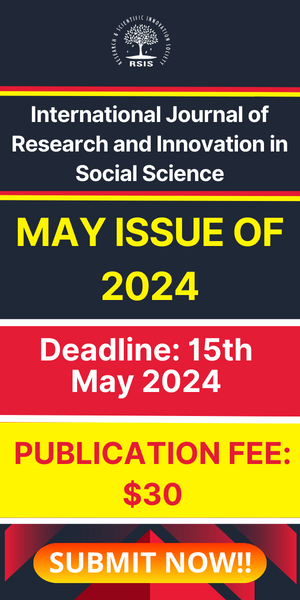
- About company
- GENERAL CONTRACTOR

+7 (495) 526-30-40 +7 (49657) 0-30-99
THE HISTORY OF THE COMPANY CREATION
1993 how the construction company remstroy was created the year 1993 was a period when a lot of construction companies, which had been working successfully during the soviet times and had rich staff capacity, were forced to cease their activity for various reasons. a lot of capable specialists either had to look for another job or change their field. but there were also those who were willing to realise their potential in the field of construction in accordance with the received degree and the experience they had accumulated. thus, in 1993 in elektrostal (moscow oblast) a group of specialists and people sharing each other’s ideas, who had enormous educational background and the highest degree in architecture, organized and registered ooo firm erg which began its rapid development and successful work, offering its service both on the construction market and other areas. 2000 industrial construction is the main area seven years of successful work have shown that combining different types of activities in the same company is not always convenient. and in the year 2000 the founders of ooo firm erg decided to create and register a monoprofile construction company ooo remstroy construction company. industrial construction was chosen as the priority area. it was in this area that the directors of ooo sk remstroy began their working life and grew as specialists. in order to achieve the set goal, they selected a mobile team of professionals in the field of industrial construction, which allows us to cope with the tasks assigned to ooo sk remstroy throughout russia and the near abroad. 2010 manufacturing of metal structures we possess modern equipment that allows us to carry out the entire cycle of works on the manufacture of metal structures of any complexity without assistance. designing – production – installation of metal structures. a staff of professionals and well-coordinated interaction of the departments let us carry out the work as soon as possible and in accordance with all customer’s requirements.” extract from the list of members of self-regulatory organizations, construction.
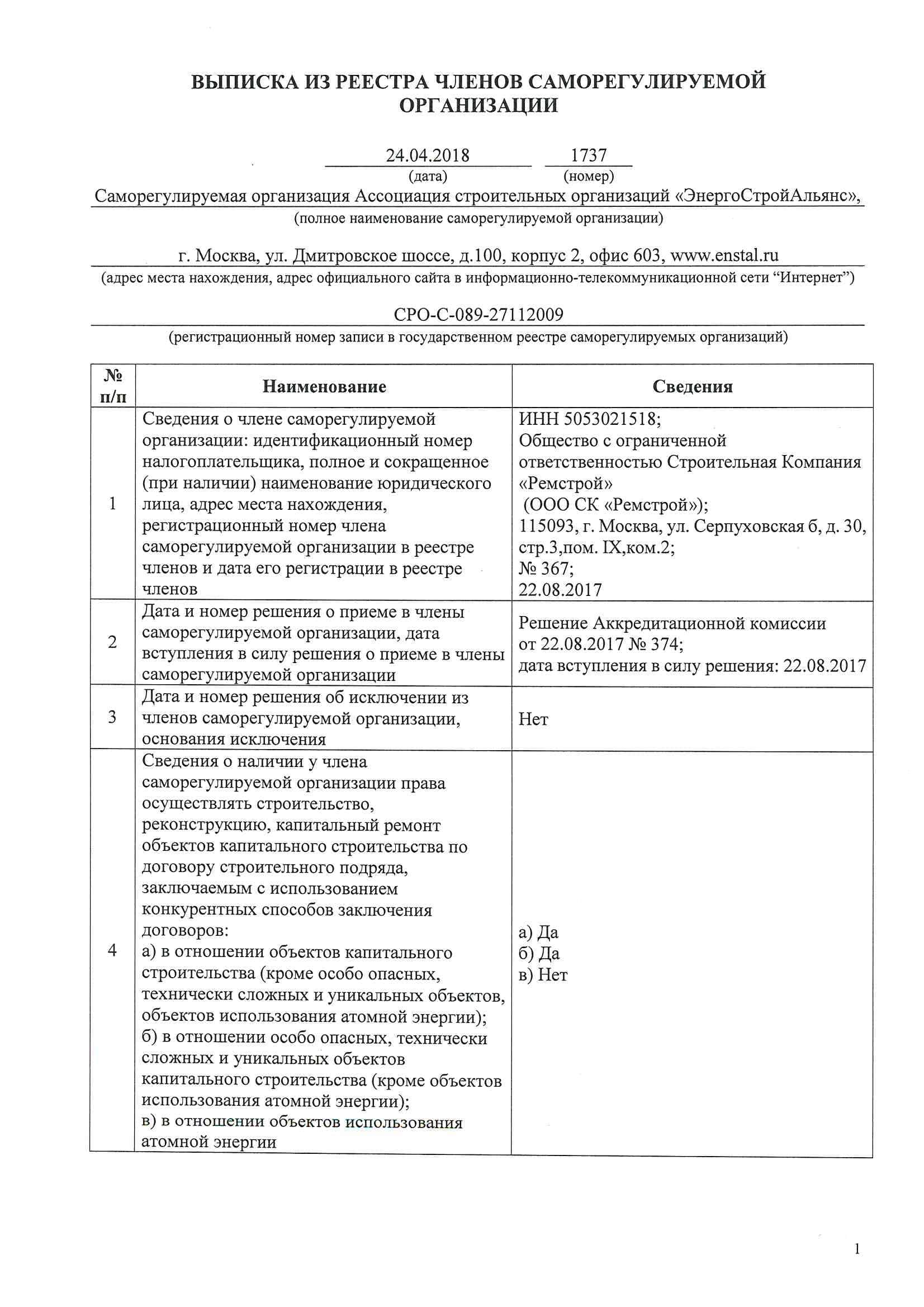
LICENSE OF MINISTRY OF EMERGENCY SITUATIONS
Certificates, system of managing quality.
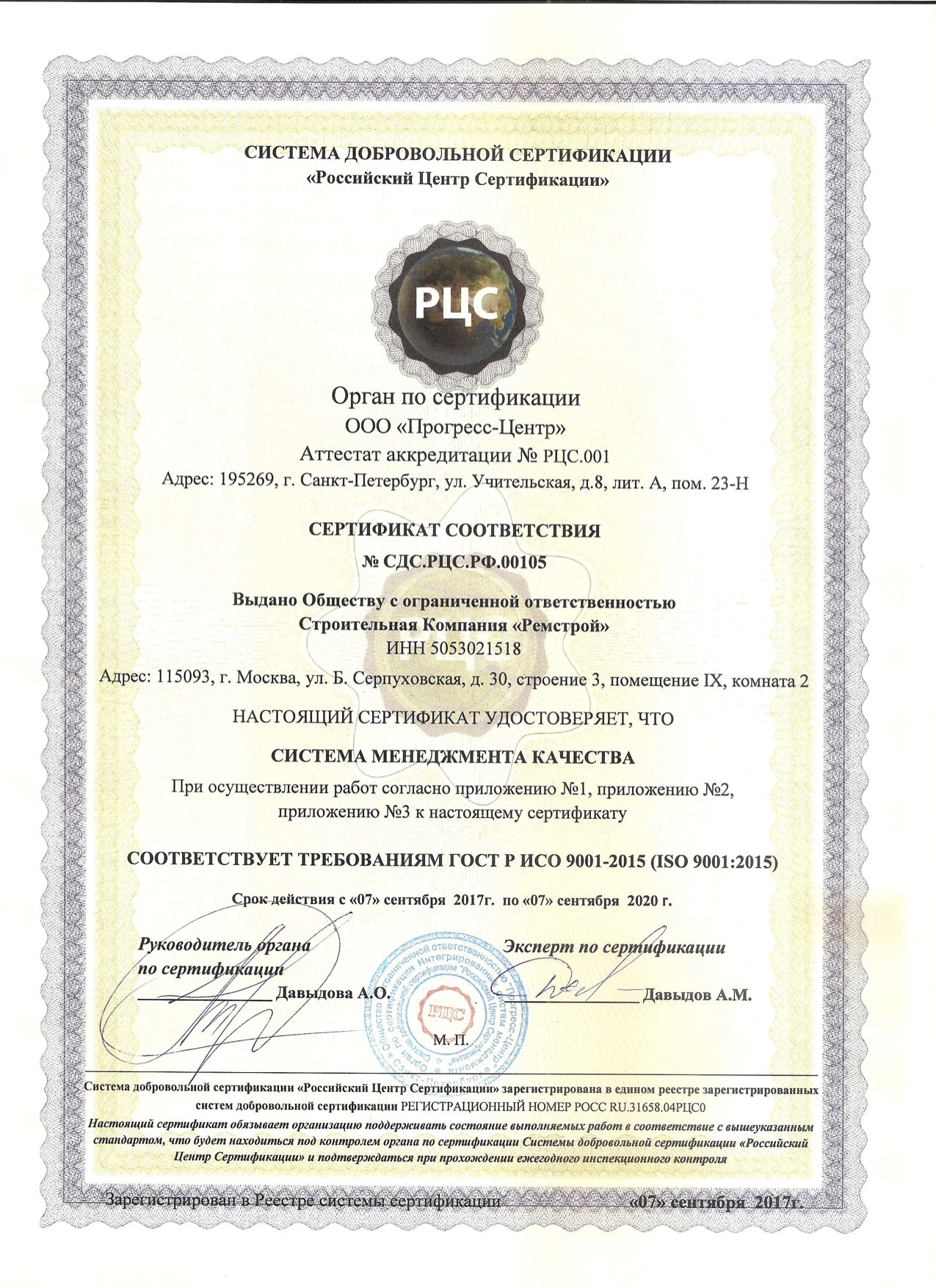
SYSTEM OF ECOLOGIAL MANAGEMENT
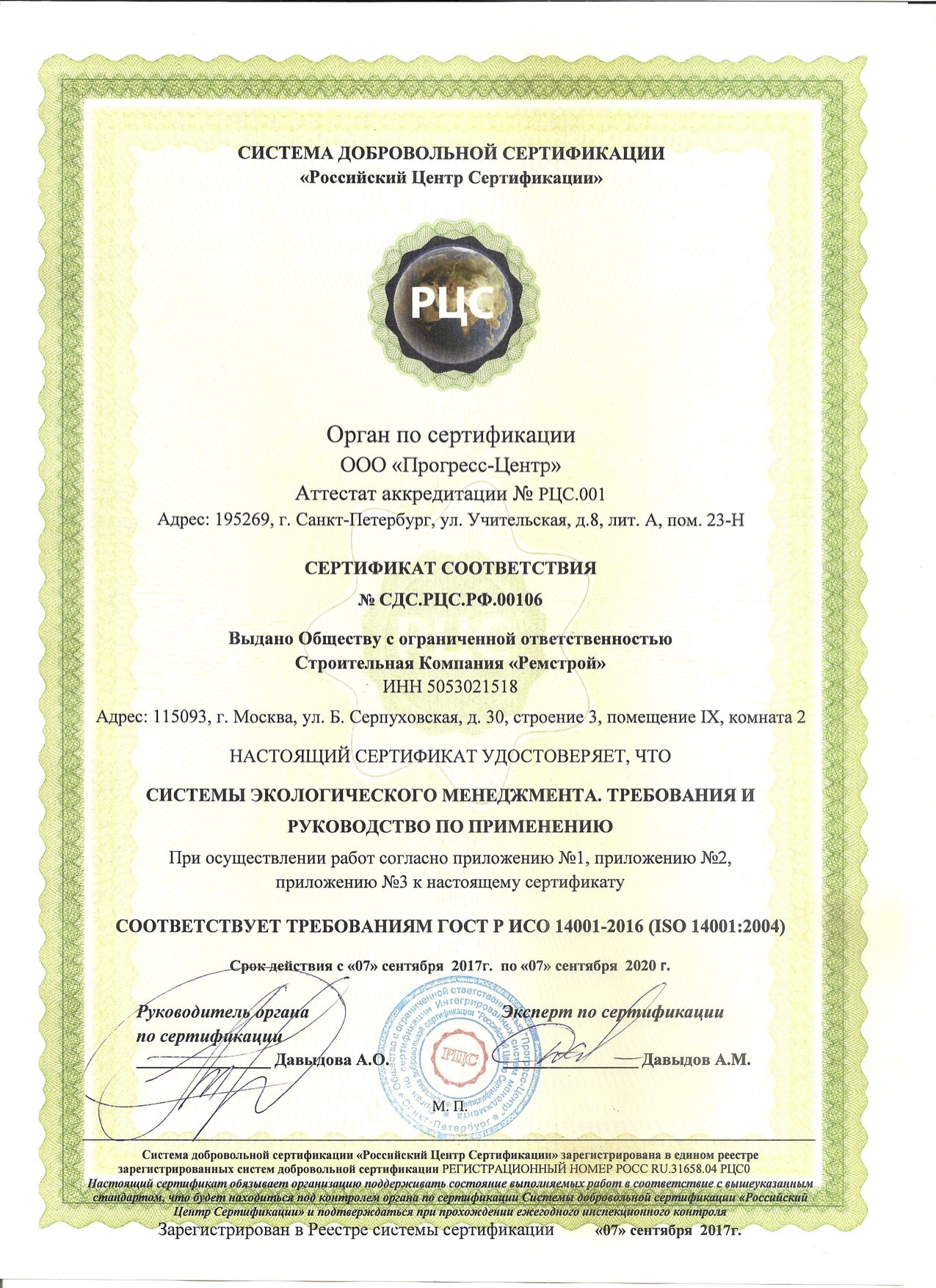
SYSTEM OF OCCUPATIONAL SAFETY AND HEALTH MANAGEMENT
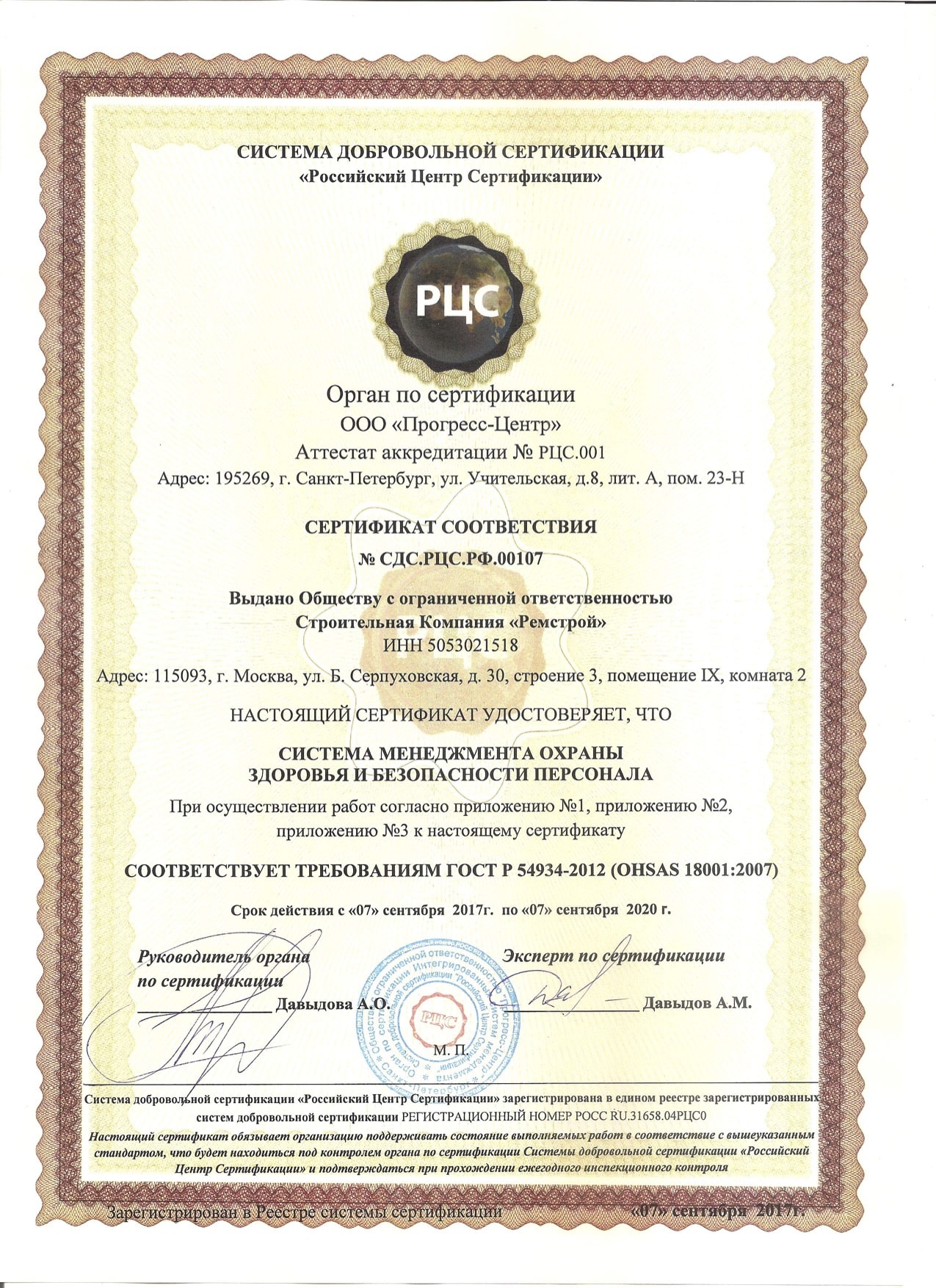
LETTERS OF RECOMMENDATION
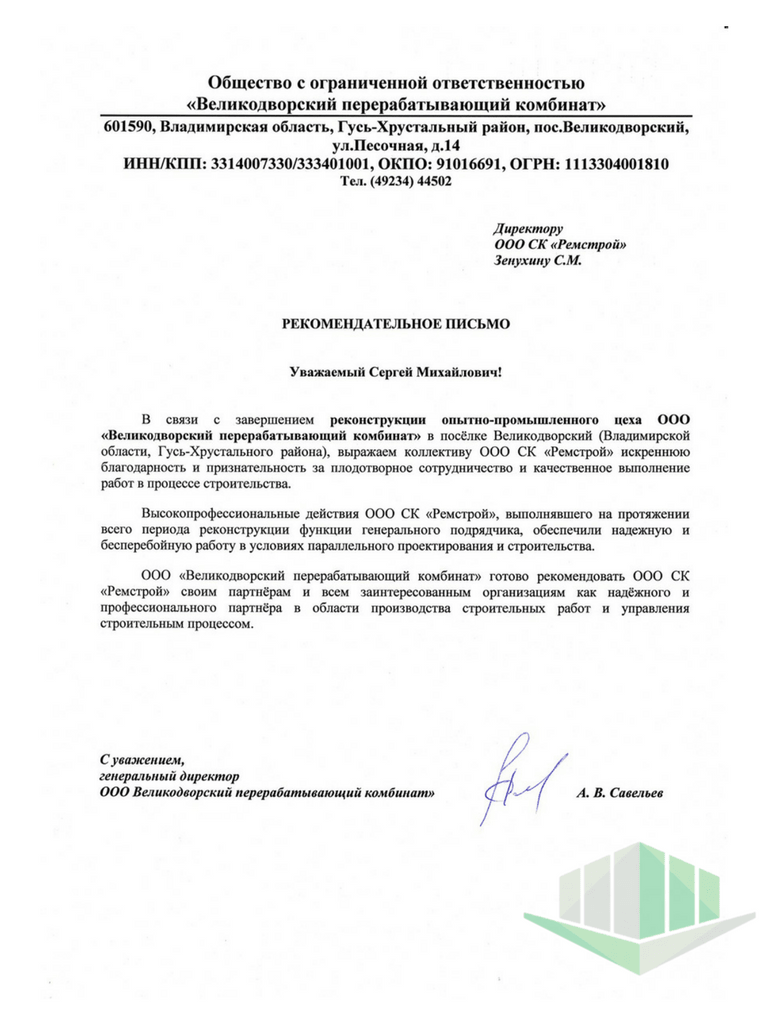
THE GEOGRAPHY OF CONSTRUCTION SITES
YOU CAN FIND MORE INFORMATION ON THE CONSTRUCTION SITES OF OOO REMSTROY ON THE PAGE OF THE SITE
OUR CLIENTS
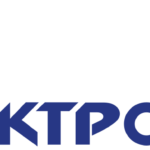
http://remstroi.pro/yandex-promyshlennoe-stroitelstvo

Image Unavailable

- To view this video download Flash Player

XL Flag Elektrostal Moscow oblast | landscape flag | 2.16m² | 23sqft | 120x180cm | 4x6ft - 100% Made in Germany - long lasting outdoor flag
Purchase options and add-ons, about this item.
- 100% Made in Germany » ... because the first impression last, quality flag for representative purposes *****
- State-of-the-art High-Tech Outdoor Fabric » One air-permeable 110 GSM Polyester to keep wind forces low and lifetime high
- Mirrored Back » Image printed on the front, mirrored image 100% visible on the rear side
- Landscape flag | 2.16m² | 23sqft | 120x180cm | 4x6ft
- Show your pride for your hometown with the Elektrostal flag! Made with quality materials and vibrant colors, this flag is the perfect way to display your patriotism and love for your city. Fly it proudly at home, at events, or even in your car. Get yours today and show your Elektrostal pride!
- The flag of Elektrostal, Moscow Oblast, is a striking combination of Old Glory red, representing strength and courage at 81%, complemented by a subtle touch of light grey at 5% for balance and harmony. The bold black stripe at 3% adds a touch of sophistication, while the shimmering gold stripes at 3% each symbolize prosperity and success. The flag is completed with a touch of very dark grey at 1%, representing the city s resilience and
- Elektrostal Moscow oblast
Product information
Warranty & support, looking for specific info, product description.
Flag: Elektrostal Moscow oblast landscape flag | 2.16m² | 23sqft | 120x180cm | 4x6ft Elektrostal Moscow oblast Elektrostal obwód moskiewski , flaga ???????????? ?????????? ??????? Since we know how important your external presentation is, we print our Elektrostal Moscow oblast flag for your representative appearance using the most modern machines in Germany. To ensure your maximum flexibility, we have equipped the flags with quality metal eyelets, to let you simply attach these flags to any flagpole. To let you use the flags for a long time, we have strengthened the flag using double safety seams and a tear proof strap at the side of the pole. Due to the quality of this business flag, you show a particular degree of the closeness to Elektrostal Moscow oblast. Details about this flag This landscape Elektrostal Moscow oblast flag is a quality product Made in Germany made of 110g/m² gloss polyester. This Elektrostal Moscow oblast flag is wind- and weather-resistant and highly durable. The flag colors are intensive and UV-resistant. This flag is specially made for outer space. This Elektrostal Moscow oblast flag will be delivered with a double safety-seam as well as with 2 metal eyelets to hoist at the flag pole. The metal eyelets give you great flexibility for placing this flag on any flagstaff. The mast side is reinforced with a white hem. The quality flag material and the metal eyelets will take care of a long endurance of this Elektrostal Moscow oblast flag. If required, the flag can be washed at 60 degrees Celsius. Recommended height of flag pole Elektrostal Moscow oblast flags of 2.16m² | 23sqft | 120x180cm | 4x6ft look best with flagpoles of around 6m | 18ft height. Need a bigger size or an other configuration? We can provide bigger sizes, other configurations, exclusive indoor ...
Customer reviews
Customer Reviews, including Product Star Ratings help customers to learn more about the product and decide whether it is the right product for them.
To calculate the overall star rating and percentage breakdown by star, we don’t use a simple average. Instead, our system considers things like how recent a review is and if the reviewer bought the item on Amazon. It also analyzed reviews to verify trustworthiness.
No customer reviews
- Amazon Newsletter
- About Amazon
- Accessibility
- Sustainability
- Press Center
- Investor Relations
- Amazon Devices
- Amazon Science
- Sell on Amazon
- Sell apps on Amazon
- Supply to Amazon
- Protect & Build Your Brand
- Become an Affiliate
- Become a Delivery Driver
- Start a Package Delivery Business
- Advertise Your Products
- Self-Publish with Us
- Become an Amazon Hub Partner
- › See More Ways to Make Money
- Amazon Visa
- Amazon Store Card
- Amazon Secured Card
- Amazon Business Card
- Shop with Points
- Credit Card Marketplace
- Reload Your Balance
- Amazon Currency Converter
- Your Account
- Your Orders
- Shipping Rates & Policies
- Amazon Prime
- Returns & Replacements
- Manage Your Content and Devices
- Recalls and Product Safety Alerts
- Conditions of Use
- Privacy Notice
- Consumer Health Data Privacy Disclosure
- Your Ads Privacy Choices

IMAGES
VIDEO
COMMENTS
BARANGAY HEALTH CENTER MANAGEMENT SYSTEM (BHCMS) A System Design Project Presented to the Faculty of College of Computer Engineering University of Cebu - Lapulapu and Mandaue A.C., Cortes, Looc, Mandaue City, Cebu In Partial Fulfilment Of the Requirements for System Analysis and Design By ANTASUDA, VAN BARRIENTOS, MICHAEL JOHN CABALHUG, VERLIN GRACE DOROY, FLORIE MAE MARCH 2020 INTRODUCTION ...
This study intends to improve the existing manual way of Barangay Villamonte Health Center. The Barangay Health Management System is an automated information system that is designed for keeping, and evaluating the residents' heath records. Conceptual Framework. Figure 1 : Conceptual Framework of BHMS.
A Guide for the Establishment of a Barangay Health Management Council: An Initiative to Strengthen the Health System and Improve Services at the Barangay Level through Better Health Leadership, Management, and Governance. Submitted to the US Agency for International Development by the Systems for Improved Access to
3 PROJECT STRUCTURE 3.1 Components The proposed system is divided into multiple functionalities that is intended majority of the transactions performed in a barangay health services center to further help the barangay health workers. As such were also referred from the forms, documents and roles of responsibilities made known to the proponent.
BHCMS Barangay Health Center Management - Free download as PDF File (.pdf), Text File (.txt) or read online for free.
The Barangay Health Center is the lowest branch of the organizational setup of the Primary Health Care system; hence it is where the first contact of the health care system with patient occurs. It administers free basic health services like maternal health care, immunization programs and free medicines, and is concerned with the improvement and ...
Abstract. The study aimed to design and develop a Barangay Health Information System that integrates Google Maps as a key component. It utilizes rapid application development methodology and ...
BARANGAY HEALTH CENTER MANAGEMENT SYSTEM (BHCMS) A System Design Project Presented to the Faculty of College of Computer Engineering University of Cebu - Lapulapu and Mandaue A.C., Cortes, Looc, Mandaue City, Cebu In Partial Fulfilment Of the Requirements for System Analysis and Design By ANTASUDA, VAN BARRIENTOS, MICHAEL JOHN CABALHUG, VERLIN GRACE DOROY, FLORIE MAE MARCH 2020 INTRODUCTION
Community health workers (CHWs) are an important cadre of the primary health care (PHC) workforce in many low- and middle-income countries (LMICs). The Philippines was an early adopter of the CHW model for the delivery of PHC, launching the Barangay (village) Health Worker (BHW) programme in the early 1980s, yet little is known about the factors that motivate and sustain BHWs' largely ...
Based on the thorough evaluation of the experts and respondents, the Barangay Integrated Management System with Mobile Support is highly usable, secured, efficient, and provides a fast and easy way to manage residents' profile, manage public information, manage supplies, manage complaints, set appointments, manage medical transactions, and ...
The performance of Barangay Health Center is more on the positive expectations especially when all the services and programs have been implemented and satisfies its residents. Expectation Confirmation theory involves four primary constructs: expectations, perceived performance, disconfirmation of beliefs, and satisfaction.
an intelligent healthcare system named VHISION for Barangay Barangka Drive in. Mandaluyong City that provides a dashboard of data visualization from the. analyzed electronic health records (EHRs ...
The evaluation conducted on the BHIS implemented using Laravel Framework concluded that it is highly effective in terms of usability, relevance, functionality, maintainability, and portability, highlighting the system's potential to significantly enhance health information management and healthcare services delivery at the barangay level. The study aimed to design and develop a Barangay Health ...
As one of the healthcare providers in the community, Barangay Health Workers (BHW) becomes one of the vital parts of the health care system in the Philippines as their essential role is to provide health education and primary health care services (e.g., maternal and child health, first aid, environmental health) and link clients to health ...
Development of a Web-Portal Health Information System for Barangay. March 2023. DOI: 10.1109/ICIET56899.2023.10111439. Conference: 2023 11th International Conference on Information and Education ...
Furthermore, even in the most remote barangays, BHWs are regarded as nurturers and health care providers for their people. The work of a barangay health worker is crucial to the success in delivering better health care services to the entire Filipino nation (Taburnal, 2020). As stated in the Implementing Rules and Regulations, Section 3, Rule 4 ...
Current System Use. Barangay Basak Health Center is using a manual system in terms of implementing medical services, health programs, health monitoring and profiling. These transactions as implemented by nurse in-charge. and barangay health workers in their station are done manually. Also the archiving of the Patient's records
Gupta umd 0117N 20854 - helpful. SIA - 101 Lab Activities 01 and 02 Rubric. LONG TEST NO. 1 (PLAN UNIT Assembly) RVA 5 - Community immersion, students are going to help and provide assistance to the. Inbound 71668879692012 70252.
2000. Seven years of successful work have shown that combining different types of activities in the same company is not always convenient. And in the year 2000 the founders of OOO Firm ERG decided to create and register a monoprofile construction company OOO Remstroy Construction Company. Industrial construction was chosen as the priority area.
The study reflects that the barangay office and the barangay health center can greatly benefit by using the developed system in providing better and faster services to the people and limit face to ...
Elektrostal , lit: Electric and Сталь , lit: Steel) is a city in Moscow Oblast, Russia, located 58 kilometers east of Moscow. Population: 155,196 ; 146,294 ...
Elektrostal is a city in Moscow Oblast, Russia, located 58 kilometers east of Moscow. Elektrostal has about 158,000 residents. Mapcarta, the open map.
Amazon.com : magFlags XL Flag Elektrostal Moscow oblast | landscape flag | 2.16m² | 23sqft | 120x180cm | 4x6ft - 100% Made in Germany - long lasting outdoor flag : Outdoor Flags : Patio, Lawn & Garden